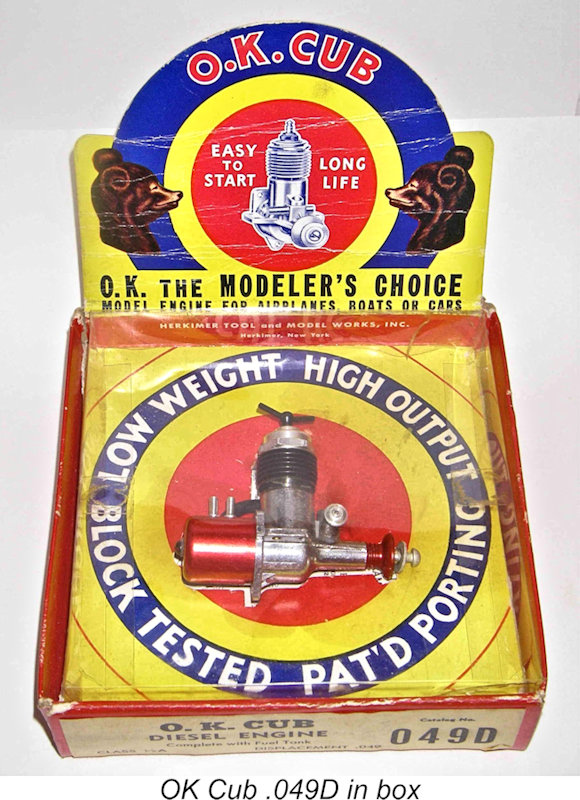
|
|
The OK Cub Diesel Story
My original article on the OK Cub diesels was published in October 2008 on the late Ron Chernich’s “Model Engine News” (MEN) website. I’m re-publishing it here partly to prevent its loss as Ron’s now-frozen and administratively-inaccessible site steadily deteriorates due to lack of any opportunity to maintain it. However, I've also taken advantage of the opportunity to revise certain aspects of the text to reflect additional information which has since become available. Let's start at the beginning! Background
WW2 had placed large numbers of American servicemen in Europe at the very time when the development of the model diesel was just getting into its stride in that geographic region. As one would expect, a proportion of these young Americans were aeromodellers in civilian life, and some of them brought model diesel engines of European manufacture back to the USA during the immediate post-war years. These engines in turn inspired a number of US manufacturers to try their own hands at designing, producing and marketing home-grown American model diesel engines. Notable among these early US efforts were the truly excellent Drone fixed-compression diesels along with other less prominent but equally noteworthy efforts such as the Vivell, Mite, Micro, C.I.E. and Speed Demon diesels, not forgetting the deservedly However, none of the early US-made diesel designs were able to withstand the market onslaught of the glow-plug motor which began in late 1947 when Ray Arden introduced the commercial miniature glow-plug, making spark ignition essentially obsolete. Thereafter, the American modelling scene was dominated by glow-plug motors in all displacement categories. All of the early post-WW2 American diesels quickly fell by the wayside. Meanwhile, development of the model diesel continued in Europe. By the early 1950's, the performance of these units had considerably surpassed that of the average glow-plug engine, at least in the smaller sizes and in general-purpose applications. Although typically a little heavier and bulkier than its glow-plug counterpart, the early 1950's diesel had two very marked advantages - one, it produced substantially more torque at lower speeds, which allowed it to swing the larger and hence more efficient props which were then These advantages were by no means lost upon forward-thinking US manufacturers. In the early to mid-1950's, several of them set out to re-evaluate the potential of the diesel in the context of the US marketplace. One of these manufacturers was the legendary Dick McCoy, who started out in the 1940's designing spark ignition and (later) glow-plug engines for the Duro-Matic Products Co. of Hollywood, California but began marketing his smaller designs as of early 1953 in the name of the McCoy Products Co. of nearby Culver City, California – apparently a Duro-Matic subsidiary. The very first product introduced under the new company banner in April 1953 was the original radial mount McCoy Duro-Glo .049 cuin. diesel. Interestingly in view of the engine's name, this was not a diesel conversion of an existing glow-plug model - it was an all-new purpose-built diesel design. A glow-plug The light and compact 1953 McCoy Duro-Glo diesel showed great potential, although the earlier versions were subject to crankshaft failures, necessitating a re-design of the crankshaft fairly early on. However, once this matter received the necessary attention, the revised engines proved to be excellent performers if properly managed, matching and in many cases beating the performance of their similar-displacement European counterparts as well as being substantially lighter than most. A further revised version appeared in late 1954 featuring an even stronger crankshaft running in a far sturdier case which was equipped with beam mounts. A very powerful scaled-up .099 cuin. version of this model was also released in late 1954. But that's another story, to be read elsewhere. Returning now to 1953, the diesel developments over at McCoy were by no means lost upon Charles Brebeck Senior, founder and owner of the Herkimer Tool & Model Works Inc. located at Herkimer, New York. This company had been manufacturing the famous OK line of model engines since 1938. Brebeck quickly decided that if diesels were to make a come-back on the American modelling scene, OK would be very much a part of that movement! His efforts form the central subject of the following discussion. In The Beginning
Using skills and knowledge gained at Rolls Royce, Brebeck became known as one of the best rebuilders of automotive axle bearings and brake units in the State of New York. In 1921 at the age of 28 he moved the family to the village of Herkimer, New York, a community which was served by both the New York Central railroad and the Erie Barge Canal. Here, with partners Bert R. Haile and Harry Bliss, he opened the Interstate Bearing Co. This proved to be the right business at the right time. The company grew, expanding into an outlet for Packard auto parts and Indian motorcycles. The onset of the Great Depression did not derail the company, which remained in business throughout. Charles Brebeck’s involvement with model engines began almost by chance in 1937 when he was 44 years old. His 20-year-old son Charles Brebeck Jr. brought in a friend's model car engine for repair. Charles Sr.’s interest was immediately aroused, resulting in him becoming hooked on the idea of making his own product. He selected .60 cuin. as the displacement which best fit with his then-available machinery. This led to the 1938 formation of the Herkimer Tool and Model Company with himself, son Charles Jr. and Harry Bliss as partners. Bliss retired a year later, selling his shares in the company to the Brebecks for $700.
This latter series was launched in 1949, being targeted at the highly competitive evolving mass market for small engines. The original long-stroke version of the Cub .049 glow engine was the first to appear, but by 1953 there were Cub glow-plug models in .039, .049, .074, .099 and .149 cuin displacements, with a .199 cuin. Cub model set to join them in 1954 and .29 and .35 models appearing in 1955. The .149 cuin. model of 1952 was significant in being the first American glow-plug engine to comply with the displacement requirements for international free flight competition under then-evolving FAI regulations. Now all of these Cub models shared a number of common design features - in fact, they were essentially the same engine built to different scales and consequently different displacements. Their central feature was the particular form of radial porting which had been developed by Charles Brebeck Sr. Today, we refer to this porting scheme as Oliver porting, although its use in the British Oliver Tiger engines was both later and slightly different. Brebeck's idea was to form the exhaust ports in a screw-in cylinder with three or four radially-cut openings, then drill small-diameter transfer passages on an upward angle through the pillars of metal separating the exhaust ports. The idea was to reduce the blow-down period and increase transfer velocities, while also improving directional control of transfer gas.
This system had a number of advantages. One, it allowed for extremely lightweight and low-cost construction. Two, it permitted some degree of overlap between the exhaust and transfer ports. Three, it resulted in highly directional transfer gas flow. Fourth, it provided for relatively high transfer gas velocities, which gave efficient low-speed scavenging and consequently Charles Brebeck claimed that his system was covered by the terms of US Patent no. 2,179,683. Certainly, this Patent number appeared cast in relief onto the crankcases of most of the OK Cub engines. However, Brebeck's claim to protection under the terms of this particular document appears to have been a smokescreen - it turns out that this Patent had actually been applied for way back on April 18th, 1938, finally being issued on November 14th, 1939. This was long before the OK Cub design layout was even thought of! Indeed, the drawing associated with this Patent (left) shows a cross-flow loop-scavenged engine with a baffle piston. The expiry date of the Patent was November 14th, 1956.
The rest of the basic Cub design was pretty much standard American small glow motor engineering of the period. The unhardened blued steel cylinder had very thin integral cooling fins. Both head and cylinder base seals were secured using soft copper shims rather than non-metallic gaskets - very durable, and good for efficient heat transfer. The case was a brightly-finished pressure die-casting in aluminium alloy which offered a choice of beam or radial mounting. The screw-in head was turned from hexagonal aluminium bar stock. The screw-in backplate was also machined from light alloy bar stock.
The Cub engines were mass-produced to very high "consumer" standards and ran very well indeed by the yardsticks of the early 1950's. Sadly, as time went by, their performance failed to keep pace with that of their rivals, notably Cox. But that too is another story.............. The beginning of 1953 found Charles Brebeck with a thriving business and a modern factory turning out the very popular OK engines by the thousands to first-class "consumer" standards. By year's end, the millionth OK engine had been produced – a fine record. With the existing product line well established, it was time for some new offerings. The hour of the OK diesels had arrived! The OK Cub Diesels - Design Considerations When Dick McCoy designed the McCoy Duro-Glo .049 diesel in 1952, he started with a clean sheet of paper. He had doubtless learned a lot from his experiences with a barstock .099 cuin. prototype diesel which he constructed in 1951. He also had some experience with .049 engines in the form of the .049 Baby Mac glow-plug model of 1951, which he had designed for the Duro-Matic Products Co. However, he did not feel that this engine formed a suitable basis for the ½A diesel that he set out to design and manufacture. The .049 Duro-Glo diesel of early 1953 was an all-new design from the ground up. I've covered the McCoy diesels in a separate article to be found elsewhere. By contrast, Charles Brebeck saw no reason to stop doing what had got his company to where it was at that point in time. He had a well-established line of popular glow-plug engines and believed that it should be possible to develop a compression ignition set-up which would work just fine using the basic design which had served him and his company so well. But there was one fly in the ointment - the thorny issue of stress! Because of their high compression ratios and almost "explosive" ignition characteristics, working loads in model diesels were acknowledged to be far higher than those encountered in a glow-plug motor with its lower compression, point ignition source and more progressive combustion characteristics. In particular, because the entire charge in a diesel reached the auto-ignition temperature at the same time, it tended to ignite all at once - indeed, to almost (but hopefully not quite!) detonate. This event took place at or slightly before top dead centre, the result being that while the crankshaft was swinging over top dead centre so that the piston could begin its power stroke, the rod, gudgeon (wrist) pin and crankpin were all very highly shock-loaded - far more so than in a correctly-timed glow-plug motor. Worse, this shock event was repeated many thousands of times per minute.
But it didn't stop there. As far back as 1946, Brebeck had formed the opinion that even with a spark ignition engine the shock loading imposed on the working parts by the ignition of the fuel mixture just prior to top dead centre imposed levels of stress which were highly undesirable. His unique solution to this problem was to design a highly original "shock absorber" system for securing the cylinder. This was first applied to his 1946 B-29 spark ignition model and was carried on throughout the following .29 cuin. spark and glow-plug ignition models right through the Mohawk Chief era up to the 1953 Super Hothead design. Basically, the system consisted of a pair of tempered spring steel clamps which were attached to the crankcase casting by screws in the fore and aft locations. These bore at their inner ends against a flange at the base of the cylinder, thus holding it down. A thick and rather soft gasket was used beneath this flange, and this gave the hold-down system a measure of "give". When the mixture fired in the combustion chamber, the cylinder and its attached head (the OK .29 series were blind-bored) were free to rise microscopically against the hold-down clamps, thus absorbing some of the energy in the system at a time when that energy could not yet be used to drive the piston. This energy was of course stored in the strained Results speak louder than words, and it's an undeniable fact that those old OK .29 engines seemed to last forever. My own Mohawk Chief ran and ran, and is still a great runner today, as were several others that I once owned. Brebeck himself noted later that so few of these engines were ever returned for servicing at the factory that in 1952 he discontinued placing serial numbers on them! Accordingly, he had good reason to believe that his efforts to reduce internal shock loadings in his original .29 series had been effective. When his thoughts turned to the design of a diesel model, Brebeck's attention naturally returned to this issue. If shock loadings resulting from the ignition process were an issue for spark-ignition and glow-plug engines, how much more so for a diesel! To compound the matter, Brebeck wished to utilize as much of the existing OK Cub design as possible. However, these engines had been designed to deal with the far lower stresses imposed by glow-plug operation - something would clearly have to be done to deal with the far higher stresses imposed by operation as a diesel. Now there were two ways to go here. Firstly, Brebeck could simply beef up all of the stressed components and hope that they held up under the stresses of life as a diesel. This was the "traditional" approach. However, there was only so much that could be done in this area without departing significantly from the basic OK Cub design. In particular, Brebeck did not want to be forced to produce an entirely new main casting to accommodate sturdier components. However, there was a second option - he could try to incorporate measures to actually reduce operating stresses so that excessive beefing-up would not be required and the basic OK Cub design would suffice to produce a reliable diesel. This was the "outside the box" approach. In the event, Brebeck applied both approaches to the problem. Without departing radically from the established OK Cub design, he took steps to beef up the most highly stressed components, also developing his own unique approach to the reduction of internal stresses. It is the latter point which gives the OK Cub diesels a unique place in the history of model diesel development and justifies an in-depth analysis of this kind. Development and Production History of the OK Diesel Models The first decision to be taken was - in which displacement categories should diesel versions of the Cub series be developed for the mass market? This is actually one of the more interesting pieces of information which an in-depth study of the OK diesels throws up! Most people immediately think of the familiar .049 and .075 diesel models to be fully discussed below whenever the subject of the OK diesels is raised. However, these were actually not the initial diesel offerings by the company! It appears that Brebeck himself was unsure of the answer to the displacement question at the outset, hence deciding to hedge his bets by simultaneously trying out diesel versions of the basic Cub design in two fairly divergent displacement categories. Accordingly, the Herkimer company entered the diesel market in April 1953 with a pair of diesel models, neither of which was either an .049 or an .075!!
Contrary to a seemingly widespread impression, these diesel models were actually introduced with some fanfare. The May 1953 issue of "Air Trails" included an article entitled "Showcase - Model Men" which consisted of photographs of prominent model manufacturers with some of their products. These photos were taken at an unspecified major model show, probably the 1953 Model Industry Association Annual Toy Fair held in March 1953 at New York. The "Air Trails" assemblage included an image of Charles Brebeck Sr. beside a poster promoting both the OK Cub .06 and .15 diesels. He is shown holding an example of the .06 model. Herkimer also produced a promotional brochure covering the engines, as reproduced here below at the right. This can scarcely be viewed as a low key introduction!
Despite this lack of promotional fervor, some distribution within the USA undoubtedly did take place. The OK Cub .06 and .15 diesels both appeared in America's Hobby Center (AHC) advertisements in "Model Airplane News" (MAN) between May and December 1953. Indeed, the Cub .15 diesel continued to appear in AHC's advertising right through to April 1954, although the Cub .06 diesel disappeared after December 1953. Domestic marketing of the engines was not confined to AHC. In the October 1953 issue of "Air Trails", an Ohio company called "Fast Engine Exchange" advertised the OK Cub .06 and .15 diesels. However, this was the sole advertisement by this company that included those two models - their December 1953 and January 1954 placements included only the Cub .075 diesel. The January 1954 advertisement was their final placement - they ceased advertising thereafter. The June 1953 issue of "Flying Models" included an advertising listing of the Cub .06 and .15 diesel models from LANSCO Model Aircraft of South Haven, Kansas. This turned out to be that company's only listing of these engines. Nonetheless, it's clear that the new models did receive some level of distribution to multiple sales outlets across the country. There were almost certainly other such locations. It appears that the AHC, Fast Engine Exchange and LANSCO listings probably related to a single relatively small trial batch of the .06 and .15 diesel models, with the .06 model selling out first. This impression is heightened by the fact that the Cub .075 diesel which evidently supplanted the .06 model was first advertised in an OK advertisement in the October 1953 issue of MAN (see below). It seems highly unlikely that any further examples of the two pioneering models would have been manufactured thereafter. My sincere thanks to my good mate Gordon Beeby for ferreting out the above information!
Moreover, there's no evidence in the form of advertisements, media commentaries or surviving examples to support this idea. It actually appears far more likely that production of these models was confined to a single relatively small batch of each model, all of which were sold in North America. I suspect that the engines were announced with some fanfare and were distributed to certain American sales outlets, most notably AHC. The fact that they were withdrawn so quickly, being replaced by the Cub .075 diesel, implies that they failed to live up to the claims asserted by the manufacturer. It seems likely that they exhibited a tendency to fail in service, consequently being consigned to the waste bin. Such a tendency would completely explain both the lack of promotional effort and the extreme scarcity of surviving examples. Whatever the reason, few of these engines seem to have been sold in North America, and neither of the two models appears individually to have reached the 500-unit mark in terms of total production. Indeed, if they even got that far one has to wonder where they all are now ............probably still functioning in melted-down form as recycled materials in classic Buicks!! My illustrated example of the Cub .149 diesel was presented by Charles Brebeck to a friend of his, subsequently languishing unused until the passing of its former owner, from whose estate I acquired it in 2023. It thus became one of the relatively few surviving examples of this model - perhaps its unused status had something to do with its survival! A full test of this very rare engine may be found elsewhere on this website. It showed itself to be a very good runner, although there were indications that its structural integrity was perhaps a bit marginal.
My illustrated example of the 15 model features a double-armed comp screw, although the hole for the stop pin is still in evidence. It thus seems to represent a move towards the eventual design of the .049 and .075 models which were destined to be the seriously-promoted OK Cub diesel models. My 15 is also missing the “shock absorber” fitting (see below) which was a feature of the smaller models. Indications from both witness marks on the contra-piston and the length of the comp screw are that it was never present. This implies that the .15 cuin. diesel model was developed in advance of Brebeck coming up with the shock absorber idea.
The new diesel was marketed as the OK Cub .075D.The introductory factory advertisement for this model appeared in the October 1953 issue of "Model Airplane News" (MAN), as reproduced here at the right. The wording of this advertisement did nothing to clarify the true history of the OK diesels. The text stated that OK were "announcing a new OK Cub series of diesel engines" and that the Cub .075 was "the first" of these! This was manifestly untrue, as we've just seen. The company actually appears to The new .075D had the same 0.478 in. (12.14 mm) bore and 0.415 in. (10.54 mm) stroke as the Cub .074 glow-plug model for an identical displacement of .074 cuin. (1.22 cc). For some reason, the decision was taken to market the diesel version as having a displacement of .075 cuin., but the fact remains that it was actually identical in displacement to the .074 glow model - even the case bore the true .074 figure! The engine weighed a commendably light 2.12 ounces (60 gm) complete with tank and fuel line.
At this point it's necessary to step back in time to recall the fact that in 1952 a revised Cub .049 glow-plug model had been released in the form of the radial mount Cub .049X. This was followed up in 1953 with the release of the Cub .049B, which was in essence the same engine with optional beam or radial mounting and a different tank. Both of these glow-plug models featured a larger bore and shorter stroke than the original Cub .049 design. They were in fact essentially identical engines, the only real differences being in the mounting and fuel tank arrangements. They offered a substantial improvement in performance over the earlier .049 design, particularly at higher speeds.
However, by the early 1960's Comet was struggling, which was very bad news indeed for Herkimer. Recognizing their increasing dependence on the Comet operation, Herkimer wanted to help but made the mistake of doing so by extending credit to the Comet company in the form of tens of thousands of engines made and delivered "on spec" to be paid for when they and the RTF models in which they were mounted were sold. When the Comet operation eventually failed, Herkimer's production of engines for them ground to an immediate halt along with any hopes of ever getting paid for the tens of thousands of engines already supplied.
Large stocks of unused parts remained on hand at the OK factory, as did the original dies and tooling. Ted Brebeck retained possession of these assets, subsequently changing the name of the company to Mohawk Engineering Co. and periodically releasing a variety of editions of the former products of the OK factory, thus keeping the OK name alive long after the glory days had ended. By a combination of issuing new editions of old engines and undertaking custom machine work, the company and its successors somehow managed to survive the Comet debacle. It remained in operation well into the new millennium, trading latterly as OK Metal Model Products and producing a line of quality model railroad passenger cars from metal components. The company was owned by Ted Brebeck. Design Elements of the OK Diesels Returning now to 1953, this is where it gets interesting in a technical sense!! As Charles Brebeck Sr. saw it, the modifications needed to convert a basically standard OK Cub from glow-plug to compression ignition fell broadly into three categories:
Let's look at Brebeck's approach to these issues in order. Since the .049 diesel was simply a scaled-down version of the .075 design, the following comments apply to both models except where noted. 1) Provision of a suitable cylinder and head
A very praiseworthy touch was the provision of a flange at the top of the contra-piston to prevent its being screwed down too far by an unfamiliar user - a very wise provision in an engine intended for a As with the McCoy, a fibre insert in the head provided a friction source to prevent compression run-back (another feature which was to appear on FROG engines, albeit using nylon inserts rather than fibre). The use of an extremely fine thread for the two-armed compression screw further minimized this tendency, also making compression adjustments considerably less critical than they might otherwise have been once the basic setting had been found. Overall, this was a very well-considered system indeed, and it worked just fine in practice. 2) Beefing up the working components The most highly stressed components in any model engine are the conrod, gudgeon pin and crankshaft. Brebeck clearly felt that the rest of the basic Cub engine was up to the job. In particular, he evidently considered the existing steel gudgeon pin, crankpin and main journal to offer ample strength, especially when used in conjunction with the stress-reducing technology to be discussed next. Accordingly, the only steps taken in this area were:
In retrospect, it must be said that Brebeck would have done well to use a revised piston having more substantial bosses for the gudgeon pin. The standard OK Cub design used a thin-walled piston which offered minimal support to the ends of the gudgeon pin, resulting in a considerable unsupported length of pin on each side of the con-rod small end. The cyclic bending stresses on the gudgeon pin were thus considerable, and gudgeon pin failures in these engines are not unknown, although they seem to stand up well enough provided the engine is operated properly on a nitrated fuel that does not require the use of excessive compression. 3) Reducing internal working stresses Now we come to the meat of the matter! Brebeck clearly wished to use a similar "shock absorber" strategy to that employed in his earlier .29 cuin models mentioned above. But how? The use of the clamping system was precluded by the screw-in assembly used in the Cub series. Where else could some measure of "give" be built into the system??
Brebeck was careful to patent this unique arrangement, applying for US Patent no. 2,733,694 on September 8th, 1953. The Patent was finally awarded on February 7th, 1956. A review of the figures and associated text confirms that it related very directly to the shock-absorber system as applied to the OK Cub diesels. On the basis of this Patent’s application, Brebeck promoted the engines as the "world's first shock-proof diesels". As far as I'm aware, his system was never emulated by any other manufacturer of model diesel engines. Now it's beyond dispute that this was a very ingenious idea indeed! Question is - does it work?? Let's take a look at what the contemporary media had to say…………. The OK Diesels in the Modelling Media The OK Cub diesels were the subject of a number of reviews in the contemporary modelling press. It is particularly fortunate that the Cub .075 diesel was the subject of a test which was published in the British magazine “Model Aircraft”. At the time in question, tests published in this magazine included horsepower curves to go with the very informative technical reports, which were unattributed but were almost certainly prepared by Peter Chinn. The contemporary American model magazines confined themselves to publishing RPM figures for a range of propellers suitable for the engine under test. In a comparative sense the American approach is more logical, since it takes differences in torque measuring equipment and test procedures out of the picture when comparing different engines.
This being the case, we are very fortunate that Peter Chinn's interest was stimulated to the point that he somehow obtained an example for test. His tests were invariably conducted in a completely professional and impartial manner using a common dynamometer rig, thus having great value to the present-day model engine historian. The US modelling media at this time did not concern itself with the measurement of actual torque and BHP figures. However, the US media did have one great compensatory asset in the person of the resident tester for “Model Airplane News” (MAN), one E.C."Ted" Martin. There could have been few people living in North America at the time who were better qualified to assess model diesel engines. While still resident in his native England, Ted had worked for the Anchor Motor Co. of Chester, manufacturers of the well-known AMCO line of model diesels, latterly being responsible for the design of their deservedly famous AMCO 3.5 BB model of 1951. He was also a close friend and associate of the aforementioned Peter Chinn.
Recognizing the difficulty of interesting any established British manufacturer in this project, Martin decided to emigrate to North America to put his plans into action from a base on that side of the Atlantic. It so happened that General Motors (GM) Canada were then planning the development of a new V8 engine and were seeking engineers to help in this effort. Although he possessed no formal engineering qualifications, Martin applied for one of these positions and was accepted. Accordingly, following Despite his new employment with GM Canada, Martin retained ambitions of starting his own model engine company, beginning with the ultra high-performance twin BB .049 diesel design which he had evolved. He had invited Chinn to join him in this venture, but Chinn declined. Probably just as well, because this project never got off the ground, most likely because the required start-up investment proved to be beyond Martin's means at the time. However, Martin was able to maintain his close involvement with model engines by making an arrangement with MAN to become their resident engine expert and tester beginning in late 1952. He later commented that this appointment actually paid better than his full-time job at GM Canada! Martin's association with MAN was to continue for much of the 1950's until he transferred his focus to full-scale motorsport and was replaced at MAN by his old friend Peter Chinn (probably on his recommendation). Significantly for our present purposes, Martin was MAN's tester-in-residence when the OK Cub diesels came up for evaluation. There could have been few individuals in North America better qualified to critically assess the new models. The Cub diesels appeared in the following chronologically-ordered published test reports:
By far the most authoritative of the above tests were those conducted by Martin for MAN and Chinn (presumably) for “Model Aircraft”. The tests from the other two US magazines were in effect promotional commentaries based to a significant extent upon the press releases issued by Herkimer, although they did include some propeller-RPM data as well as some general handling and performance impressions. All reviews were extremely favorable, but those authored by Martin and (presumably) Chinn constitute the most authoritative contemporary commentaries available to us today. The February 1954 MAN test of the Cub .075 diesel came first, so let's see what Ted Martin had to say about that one. In reading Martin's comments, we must recall that we are listening to the voice of a very experienced model diesel designer and user, and a close associate of Peter Chinn. Martin's summary comment was that the new Cub diesel was "a really hot performer for its size". He characterized the starting and running characteristics as "delightful" and praised the general quality of the .075D. His description of the engine confirmed that it followed the standard Cub design layout in most respects, the major differences being in the ignition system.
Remember, this is a highly experienced model diesel designer and user speaking. Clearly, in Martin's mind the system was highly effective and his views must surely count for something! Reading between the lines, you can almost hear him saying to himself “Now why didn't I think of that??!!” Martin ran the engine for one hour prior to testing it, and then obtained the following propeller-rpm readings:
The diesel-minded Martin found the opportunity to put in a plug for his beloved compression ignition by drawing attention specifically to the figure for the 10x6 - try that on yer .074 glow, mate!
This Canadian source must surely have been Martin himself - other potential candidates appear to be thin on the ground! If so, it's interesting that Martin confined this comment to his British correspondents (like Chinn), hence allowing his views to be published in "a contemporary British publication" as opposed to an American periodical. There was no mention of this issue in Martin's published tests of the OK diesels in the US media. Most probably he did not want to risk offending one of MAN's major advertisers (or was told not to do so by the MAN Editor). In any case, Chinn (assuming him to be the author of the “Model Aircraft” test) did not agree with this assessment. He felt that it was mainly a matter of the user becoming familiar with the system, which he saw as having a number of advantages. He praised the inclusion of the flange to prevent over-compression, although he rightly noted that the upper limit of compression was reached at around 11,000 rpm on fuels which did not contain sufficient amyl nitrate. He also found the "shock absorber" system well worthy of comment, although he did not commit himself regarding its effectiveness. He praised the engine's smooth running at the higher speeds, but commented somewhat cautiously that it was "difficult to say whether this (was) attributable to the "shock absorber" head". He did however concede that the engine was superior in this respect to most conventional diesels, thus coming perhaps as close as he felt comfortable to actually endorsing the system. He was particularly complimentary regarding the engine's freedom from viciousness when starting, although he found starting a little less easy than Martin had evidently done.
Overall, Chinn characterized the Cub .075 diesel as a "fine little engine" which displayed "the usual fine finish and pleasing general design common to the other Herkimer-O.K. Cub models". There was clearly little disagreement between Martin and Chinn regarding the merits of the new model. In the same month of July 1954 in which the above review by Chinn appeared, Martin published his second MAN test report on an OK diesel. This time, his subject was the Cub .049 diesel which had quickly followed the .075 model into the marketplace. On this occasion, Martin took full advantage of a unique opportunity. He had previously tested the short-stroke Cub .049X glow-plug motor, of which the .049 diesel was in effect simply a compression ignition version. Here was a golden opportunity to develop a direct comparison between the characteristics of compression versus glow-plug ignition in more or less the same engine! Martin briefly reiterated his previous comments from a few months earlier regarding the changes made to convert the .049 Cub to diesel operation as well as the "shock absorber" system which was also applied to this model. But all of this had already been said in the .075 test, so the main focus of the .049 test was on the comparison between the Cub .049 diesel and glow models. Martin characterized his findings in this regard as "startling"! Once again, a range of RPM figures were obtained with selected test propellers, but this time the results obtained previously for the Cub .049X using the same airscrews were published alongside those for the diesel. Here are the published prop/RPM figures:
As can be seen, the diesel displayed a clear performance edge over the glow at all speeds up to 15,000 rpm and was still more or less level even at that speed, a finding which seemed to Martin to contradict the prevailing wisdom among US modellers regarding the relative performance of diesels and glows! He had doubtless been expecting superior low-end performance from the diesel, but evidently not the superior mid-range and level top end that he actually found. As a confirmed diesel man, he must have been quite gratified! In fairness, Martin noted that he had been using the tested Cub .049X in models since the completion of its published test. Consequently, it had improved considerably over time. However, it's equally fair for us to note that the tested diesel would almost certainly have shown a similar improvement as it freed up further with more running time. At the time of the above tests, the diesel had 1½ hours of running time, while the glow had received 2¼ hours. The direct comparison thus seems more than fair. Martin stated in his report that the Cub .049 diesel was ”the most gentlemanly diesel in our experience”, which really meant something coming from an individual of Martin's background! He commented particularly upon the freedom from viciousness when starting on small props, thus echoing the contemporary comment made by Chinn with respect to the .075 model. His summary comment was that Herkimer had produced another winner. It's probably no coincidence that Ted was soon offered an arms-length consultancy role with the Herkimer Company. There can be little doubt that this came about as a result of his very favourable reviews of the various OK Cub models. This consultancy arrangement culminated in the offer of a full-time job at Herkimer. Ted apparently considered this offer very seriously, going so far as to commence the US immigration formalities. However, when confronted with the array of questions asked by the US immigration authorities (this was during the infamous McCarthy era), Ted reckoned that many of them were both impertinent and personal in nature (not that he had anything to hide - it was a matter of principle). Accordingly, he decided that he really couldn't be bothered and stayed in Canada. He ended up working for GM Canada until 1969, when he moved permanently back to his native England. He died in 2010 at the age of 88, a very wealthy man from his involvement with motorsport. Amyway, there we have it - a ringing endorsement of the unique Herkimer diesel design from two recognized authorities on the subject of model diesels! How does present-day experience compare with Martin's and Chinn’s comments? Only one way to find out - let's run a Cub diesel! The Cub Diesels Today
So it's with some trepidation that a "traditional" diesel user views the prospect of running one of these little beasts! However, one merely has to think back to the previously-quoted test reports by Ted Martin and Peter Chinn as well as the reviews undertaken by others (all of them highly favorable) to realize that there's no logical reason to anticipate any problems. And indeed, this is found to be the case! The .075 model is the one with which I've personally had the most experience - I've both bench-run and flown these engines. As supplied, the running fits are excellent - the piston fit is typically a little slacker than in most European diesels, but the somewhat “soft” compression seal on many of these units appears to represent no barrier to easy starting.
Once running, the settings are extremely non-critical - the very fine threads used on both the compression screw and needle valve see to that. Running is extremely smooth too, just as Ted Martin reported - I'm unable to say how much of that is due to the "shock absorber" in the cylinder head, but there it is! The one limitation (if you can call it that) is the fact that when trying to run the engine fast on a small prop the upper limit of compression is reached as one tries to advance the ignition timing. Peter Chinn drew attention to this issue, and experience proves him right. Brebeck clearly (and in my view wisely) set that upper limit quite conservatively to minimize the possibility of damage being caused by over-compression - a common error among modellers who are unfamiliar with diesels. However, the available compression settings are adequate for the sizes of props most likely to be used on an engine of the particular displacement and type - on the .075, for example, a fast 7x6 would appear to be the ideal prop for sport control line work, with a 7x5 or 8x3 for free flight. The upper limit of available compression on my own current "runner" example of this engine easily accommodates such prop sizes using a nitrated fuel, as some recent bench running proved.
The steel rod has rather a narrow small end bearing, and on my trusty "runner" example there's detectable "waisting" of the rubbing portion of the gudgeon pin after some 4 hours of running in my hands, much of it in the air. A replacement pin is of course no bother to install, but this is an issue with these engines. It's a problem which is not infrequently encountered with hardened steel rods running in conjunction with steel pins. My appreciation of this issue has always led me to run the Cub diesels on a fuel containing 30% castor oil. Indeed, in reponse to an inquiry by Peter Chinn, the manufacturers specifically recommended the use of a fuel having this lubricant content. Apart from the superior lubrication provided, this has three side benefits - one, it actually increases the effective compression ratio of the engine due to the proportion of the combustion chamber volume which is taken up by the oil content at top dead centre – the old “fixed compression” approach to compression ratio adjustment. Two, it helps to create an improved compression seal with the typical slightly loose OK diesel piston/cylinder fit. The engines start and run much better with such an "oily" fuel, and should last far longer as well. Finally, the build-up of castor residue on the cylinder walls which always accompanies the use of castor oil over time tends to further improve the ability of the piston seal to resist compression and combustion pressures.
Maris bench-tested his examples of both the .049 and .075 Cub diesels, with the results reflected in the Both of Maris's examples remained in use as of my time of writing in September 2023. The .049D was installed in a 40 in. wingspan KK Snipe, which it flew on a 7x4 prop, while the .075D was powering a free flight Blackburne monoplane using a 9x4 prop. Maris commented that he really liked OK diesels! In summary, test-running and using examples of these engines today amply confirms the comments made by Martin and his colleagues all those years ago. These really are good-handling and sweet-running little engines which are also extremely light and compact for their power. Well worth a go!! Summary and Conclusion
If you get one that requires dismantling for cleaning or for some other reason, just remember that the soft steel cylinder is easily marred. Do not use a lathe chuck, pliers or a vice-grip to unscrew the cylinder!! OK made a neat clamping ring for their cylinders, and you should use one of these or a made-up equivalent. Heating the case to around 200 degrees Fahrenheit in an oven usually makes removal quite a bit easier. A very important point to note is that the piston should be unstuck in the bore and positioned at bottom dead centre with plenty of oil before any attempt is made to remove the cylinder, otherwise twisting of the rod can easily occur. Any patches of bare metal on the cylinder after removal can easily be restored with gun bluing solution. Anyone who really wants a Cub diesel should be able to find a serviceable example of one or other of these engines without too much trouble. And in my humble opinion, anyone having an interest in model diesels should do so! These are great little engines which are quite out of the common diesel rut, start and run extremely well, look really sharp, are extremely light and compact and are a lot of fun to own. Go on - give one a try! Just remember to add that nitrate, and don't forget to pour in the oil! ________________________________ Article © Adrian C. Duncan, Coquitlam, British Columbia, Canada First published on MEN October 2008 Re-published here November 2023
|
||
| |
 This time we’ll share an in-depth look at a series of model diesel engines which richly deserve to be remembered not only because of their excellent starting and running qualities but also because of a number of unusual attributes. For a start, they were designed and manufactured in substantial numbers in the USA during the mid-1950's at a time when the modellers of that country had essentially written off the diesel and had adopted the glow-plug motor more or less wholesale. But in addition, they incorporated a highly original and apparently effective design feature which made them unique in the annals of model diesel engine design.
This time we’ll share an in-depth look at a series of model diesel engines which richly deserve to be remembered not only because of their excellent starting and running qualities but also because of a number of unusual attributes. For a start, they were designed and manufactured in substantial numbers in the USA during the mid-1950's at a time when the modellers of that country had essentially written off the diesel and had adopted the glow-plug motor more or less wholesale. But in addition, they incorporated a highly original and apparently effective design feature which made them unique in the annals of model diesel engine design.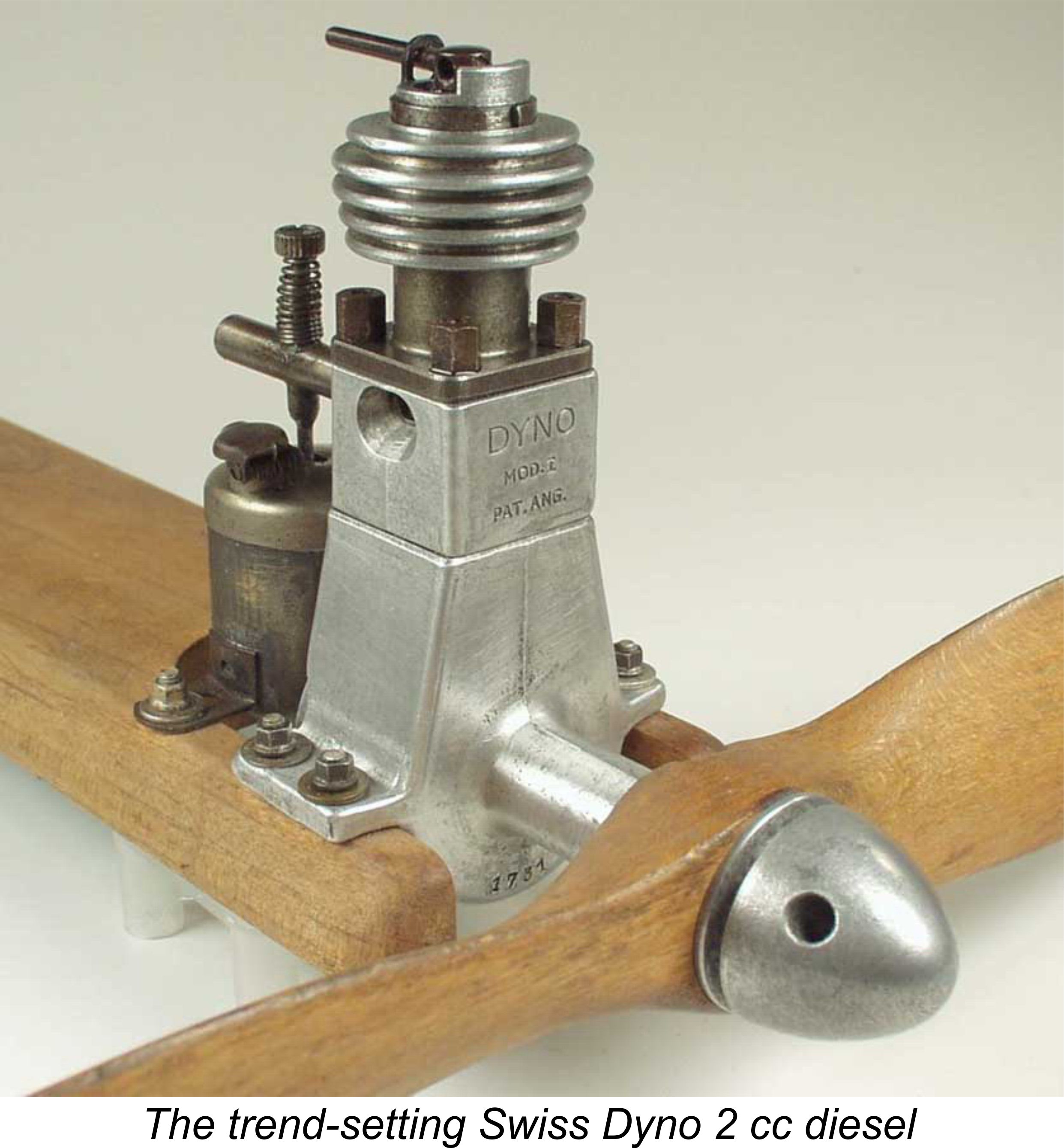 The model two-stroke compression ignition (diesel) engine originated in pre-WW2 Switzerland and was developed into a practical form during WW2 in Switzerland and several other European countries, notably Czechoslovakia (as the Czech Republic was then), Germany, Norway, Italy and France. By the end of that conflict, the broad working principles of the model diesel were well established in Europe and the development of that type of engine into its "classic" form was well underway.
The model two-stroke compression ignition (diesel) engine originated in pre-WW2 Switzerland and was developed into a practical form during WW2 in Switzerland and several other European countries, notably Czechoslovakia (as the Czech Republic was then), Germany, Norway, Italy and France. By the end of that conflict, the broad working principles of the model diesel were well established in Europe and the development of that type of engine into its "classic" form was well underway. 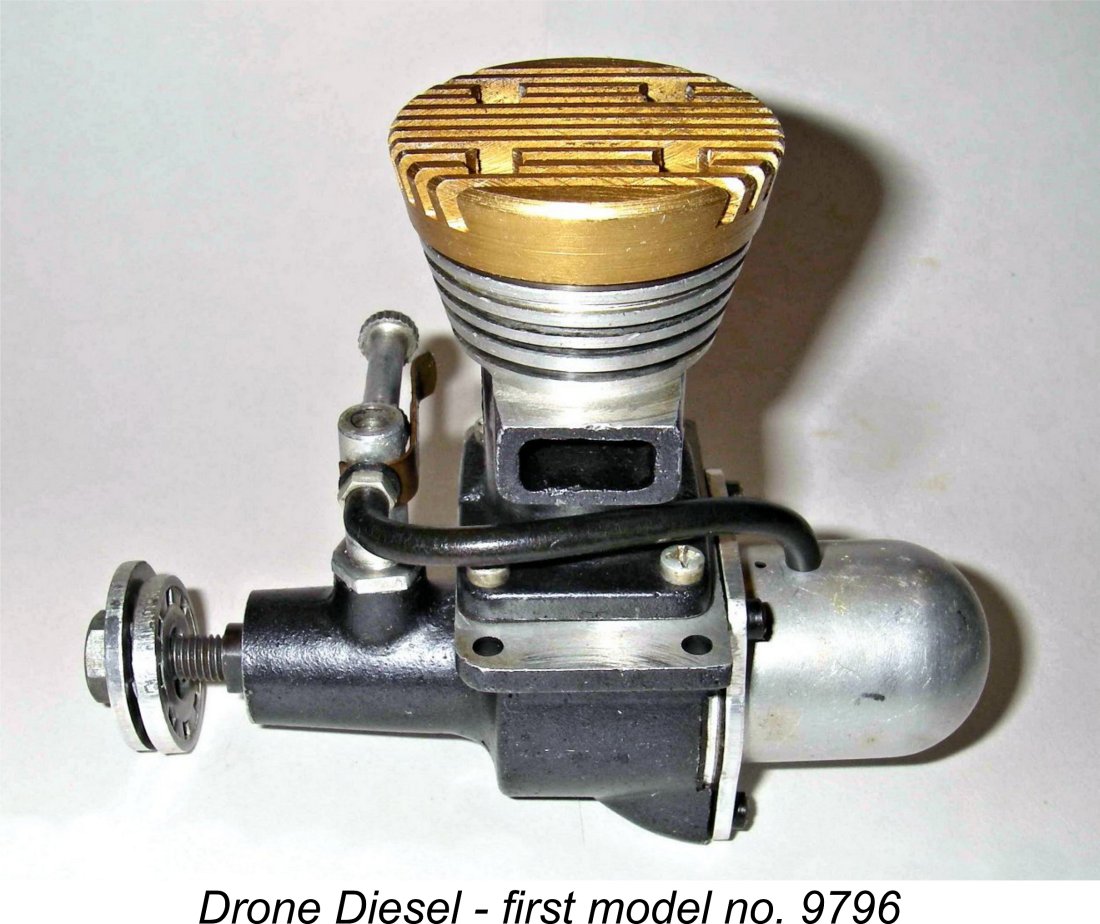
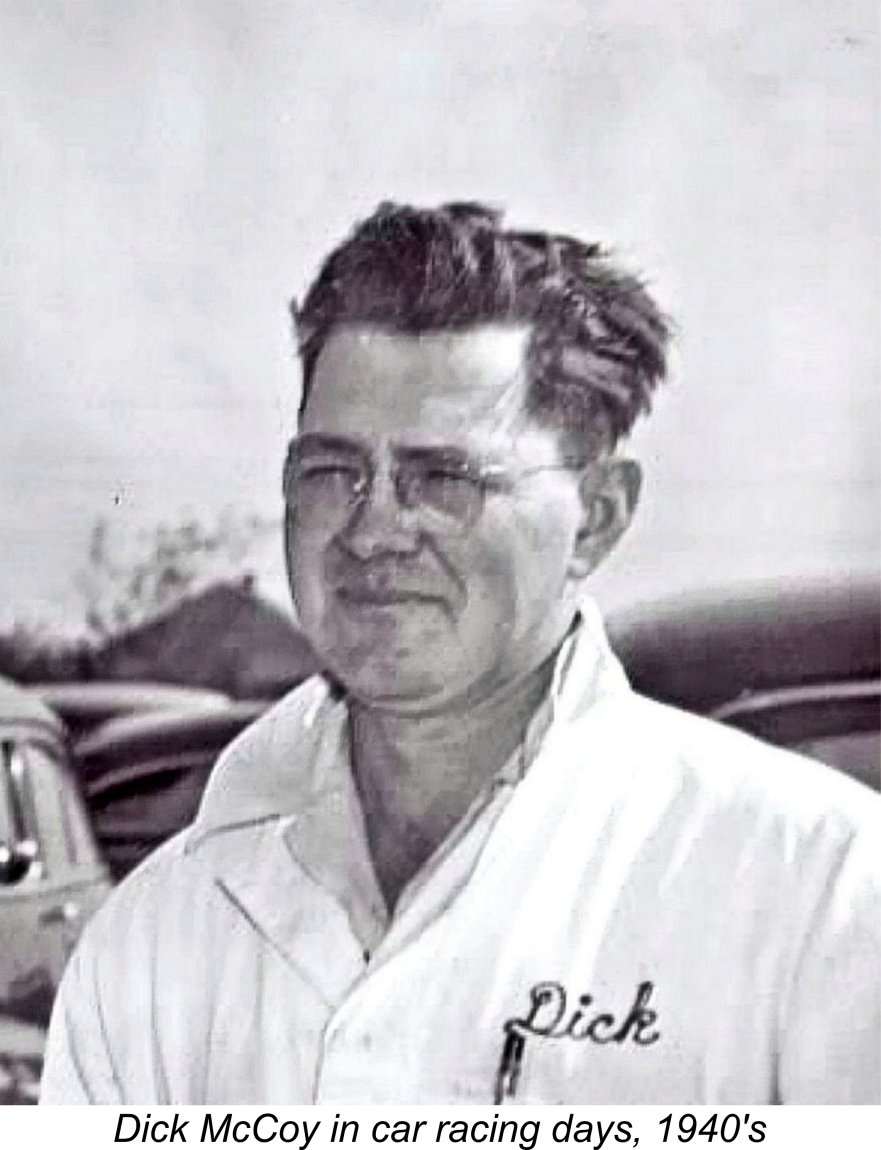 in fashion; and two, its compression ratio and hence its ignition timing were variable, allowing it to be conveniently set to run efficiently over a far wider range of operating speeds than a glow-plug motor with its relatively fixed ignition timing. A third advantage was simplicity of operation once the technique had been mastered - no plugs to burn out and no batteries or hook-up wires to manage.
in fashion; and two, its compression ratio and hence its ignition timing were variable, allowing it to be conveniently set to run efficiently over a far wider range of operating speeds than a glow-plug motor with its relatively fixed ignition timing. A third advantage was simplicity of operation once the technique had been mastered - no plugs to burn out and no batteries or hook-up wires to manage.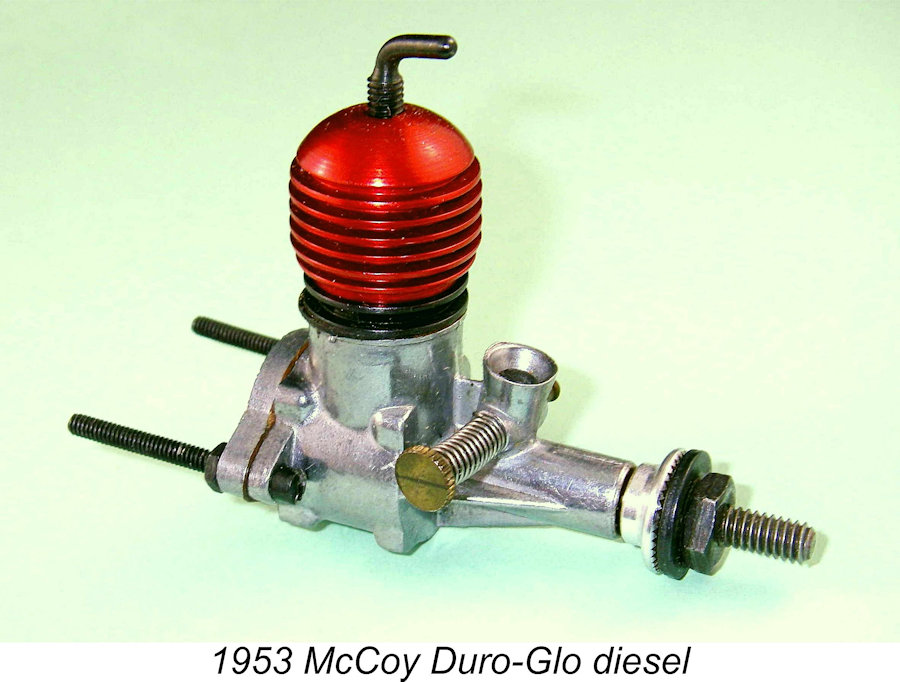
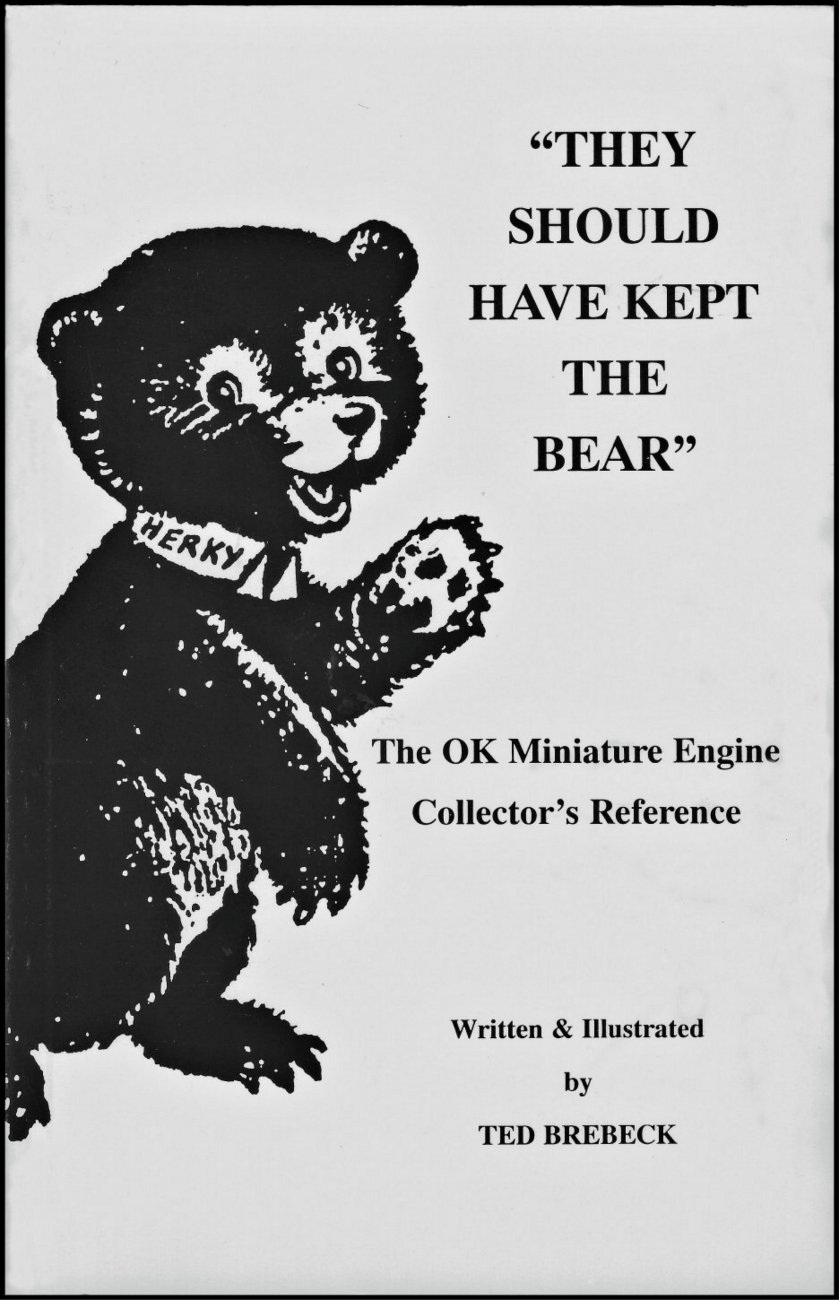 As detailed in grandson Ted Brebeck's book on the history of OK engines, "
As detailed in grandson Ted Brebeck's book on the history of OK engines, " The rest, of course, is history. Suffice it here to say that the Herkimer company met with success from the first and survived the war years, carrying straight on after the war with an ever-changing and always expanding line of model engines in various displacements. This included CO
The rest, of course, is history. Suffice it here to say that the Herkimer company met with success from the first and survived the war years, carrying straight on after the war with an ever-changing and always expanding line of model engines in various displacements. This included CO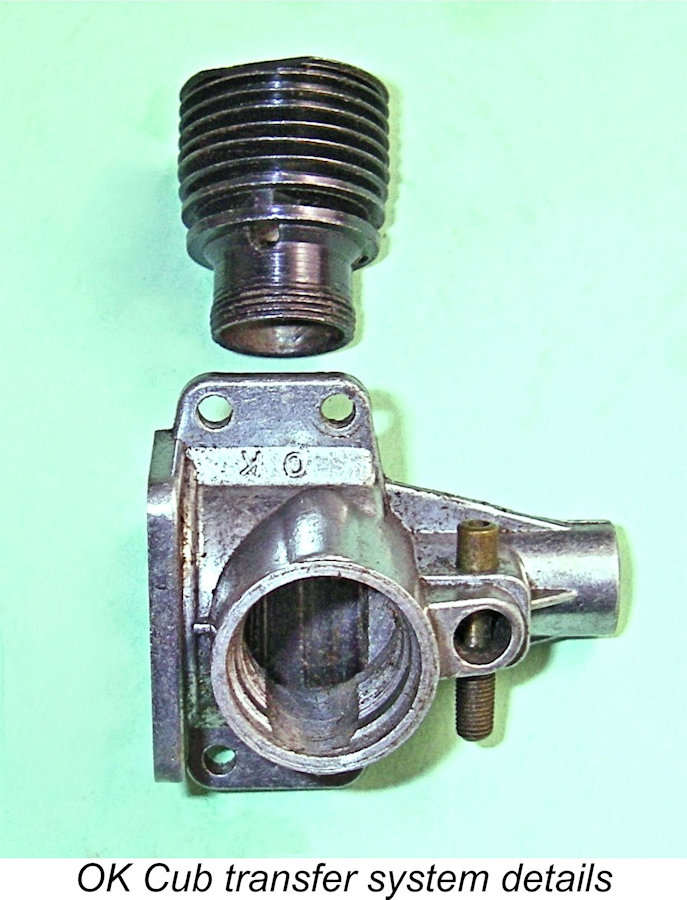 In Brebeck's design, the cylinder threaded into the crankcase. The drilled transfer ports communicated with the cylinder bore from an unthreaded portion of the cylinder wall below the exhaust. The crankcase featured a matching unthreaded portion between the cylinder seat and the female threads in the case, so that when the cylinder was screwed in place there was a clear unthreaded annular passage surrounding the entire cylinder just below exhaust port level and communicating with the bore through the transfer ports. This annular passage was fed from the main crankcase through two large cutaways, one on each side, which interrupted the female cylinder installation thread in the upper crankcase. The cast-in "bumps" visible on the exterior of the crankcase sides were included to accommodate these cutaways without undue loss of structural strength.
In Brebeck's design, the cylinder threaded into the crankcase. The drilled transfer ports communicated with the cylinder bore from an unthreaded portion of the cylinder wall below the exhaust. The crankcase featured a matching unthreaded portion between the cylinder seat and the female threads in the case, so that when the cylinder was screwed in place there was a clear unthreaded annular passage surrounding the entire cylinder just below exhaust port level and communicating with the bore through the transfer ports. This annular passage was fed from the main crankcase through two large cutaways, one on each side, which interrupted the female cylinder installation thread in the upper crankcase. The cast-in "bumps" visible on the exterior of the crankcase sides were included to accommodate these cutaways without undue loss of structural strength.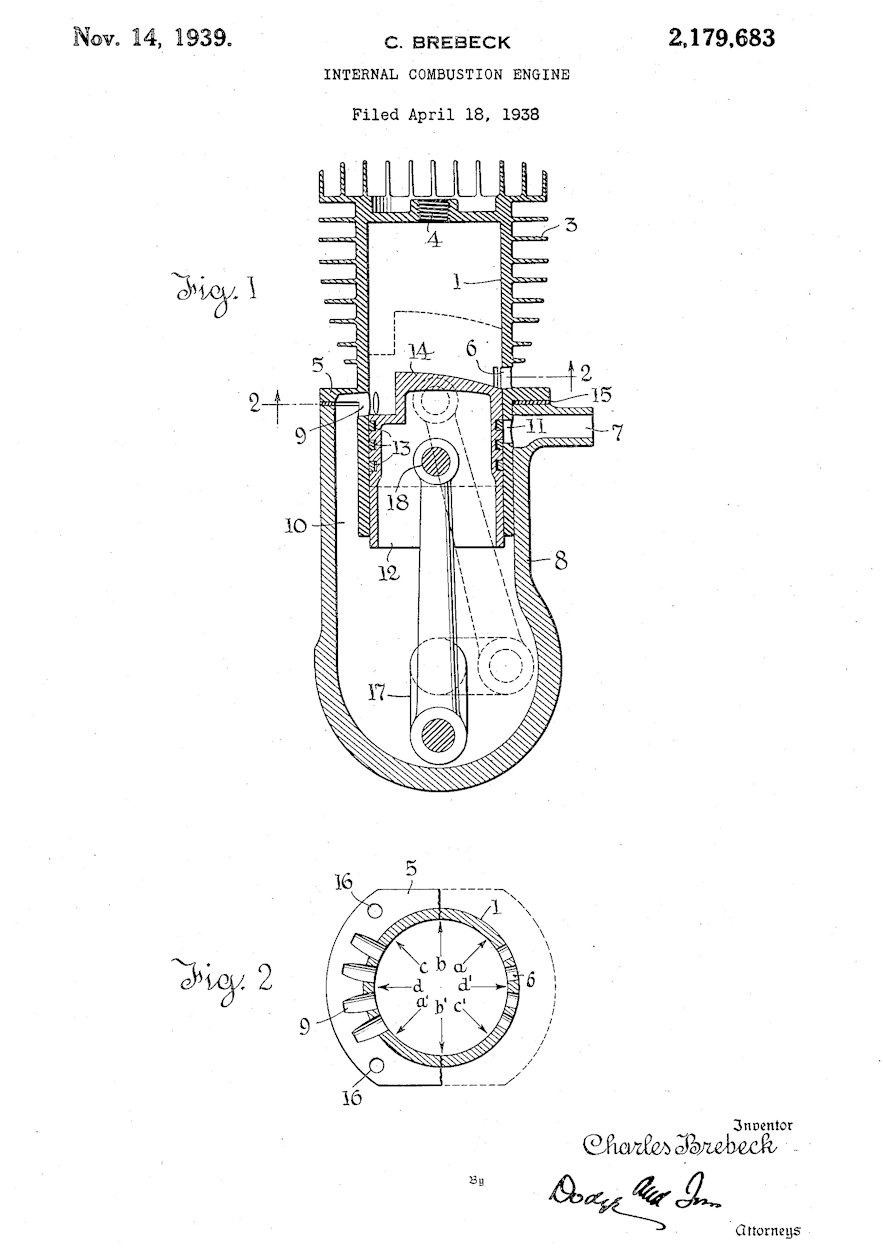 easy starting. And finally, development work was considerably simplified by the fact that changes in port timing could very easily be tried simply by the judicious use of shimming and adjustment of the transfer port overlap, often using the same cylinder.
easy starting. And finally, development work was considerably simplified by the fact that changes in port timing could very easily be tried simply by the judicious use of shimming and adjustment of the transfer port overlap, often using the same cylinder.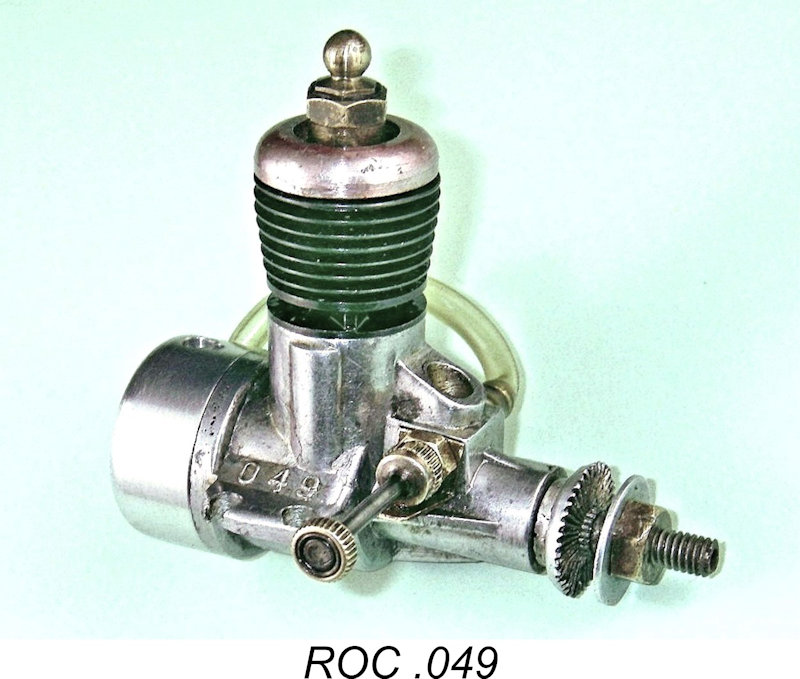 A reading of the text of this Patent reveals little connection with the design of the OK Cub series apart from the use of drilled upwardly-angled transfer ports. It seems clear that the application of this Patent to the OK Cub porting arrangement was generally seen as pretty weak, because the system was quite widely copied, with makers as diverse as
A reading of the text of this Patent reveals little connection with the design of the OK Cub series apart from the use of drilled upwardly-angled transfer ports. It seems clear that the application of this Patent to the OK Cub porting arrangement was generally seen as pretty weak, because the system was quite widely copied, with makers as diverse as 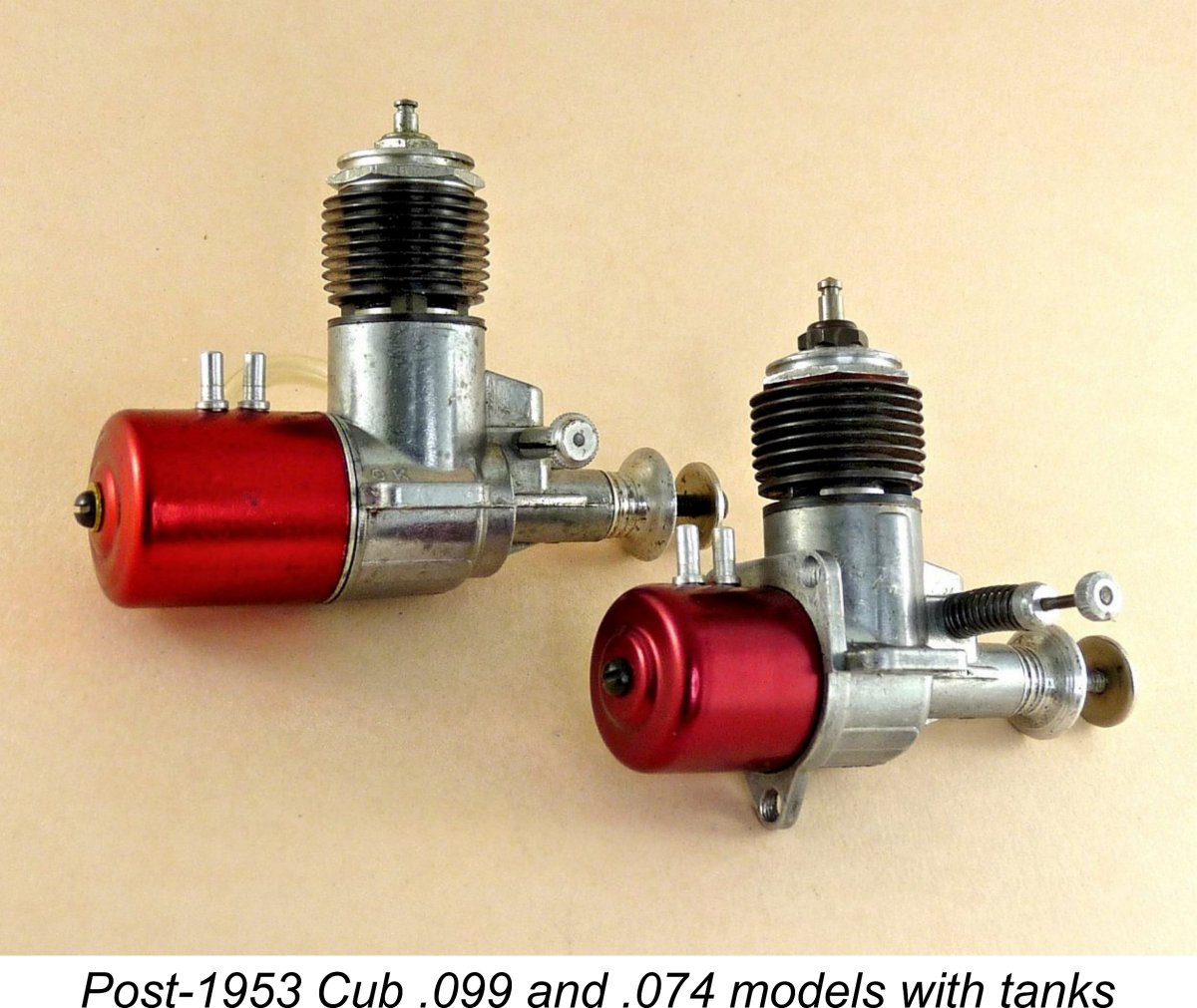 The case-hardened shaft was machined in one piece from low-carbon steel, while the rod was a light alloy die-casting. The steel gudgeon pin was swaged into the bosses of the hardened steel piston to prevent lateral movement and possible scoring of the soft cylinder bore. A square-cut induction port was formed in the crankshaft by cross-milling. This engaged with an axially elongated base section in the intake, giving rapid opening and closing of the crankshaft rotary valve. Finally, the spraybar was simply pressed into the mounting holes in the venturi, no nut being used. A very fine thread was used on the needle valve, giving relatively non-critical needle control characteristics.
The case-hardened shaft was machined in one piece from low-carbon steel, while the rod was a light alloy die-casting. The steel gudgeon pin was swaged into the bosses of the hardened steel piston to prevent lateral movement and possible scoring of the soft cylinder bore. A square-cut induction port was formed in the crankshaft by cross-milling. This engaged with an axially elongated base section in the intake, giving rapid opening and closing of the crankshaft rotary valve. Finally, the spraybar was simply pressed into the mounting holes in the venturi, no nut being used. A very fine thread was used on the needle valve, giving relatively non-critical needle control characteristics. Brebeck had a thing about ignition timing, particularly in glow-plug engines. His Cub glow-plug models were generally supplied with three .004 in. thick copper shims under the cylinder head, thus allowing some adjustment of the compression ratio and hence the ignition timing to suit the operating speed at which the engine was intended to be used. A good feature!
Brebeck had a thing about ignition timing, particularly in glow-plug engines. His Cub glow-plug models were generally supplied with three .004 in. thick copper shims under the cylinder head, thus allowing some adjustment of the compression ratio and hence the ignition timing to suit the operating speed at which the engine was intended to be used. A good feature!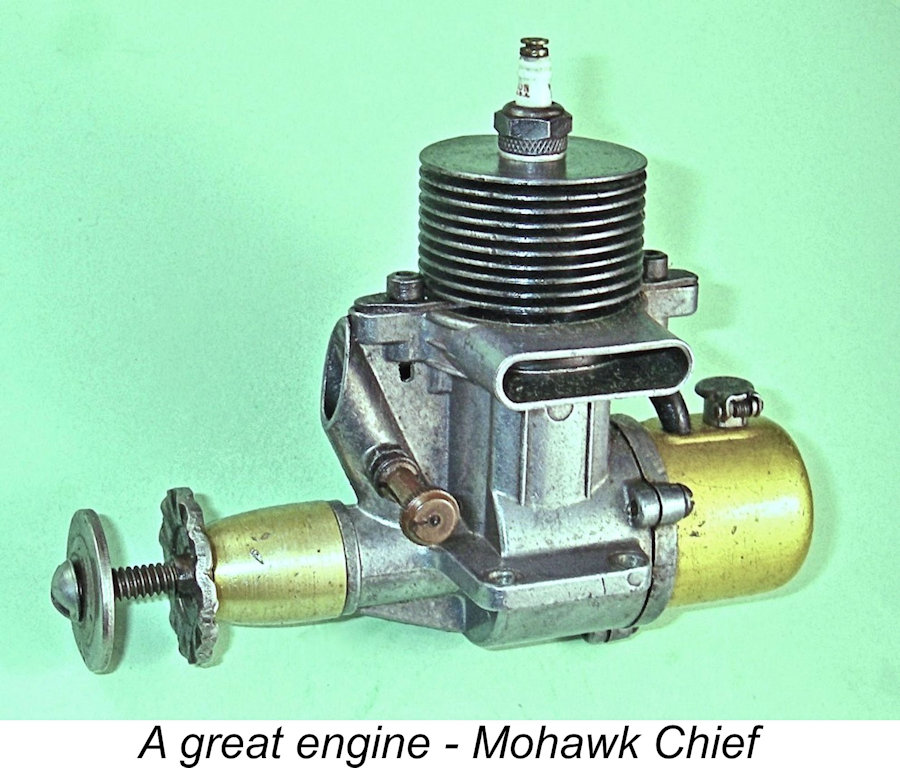 hold-down system. As the piston commenced its power stroke and the shock loading condition passed, the system returned to its normal state by releasing its absorbed energy back into the power train. At least, that was the theory, and Brebeck was a true believer!
hold-down system. As the piston commenced its power stroke and the shock loading condition passed, the system returned to its normal state by releasing its absorbed energy back into the power train. At least, that was the theory, and Brebeck was a true believer!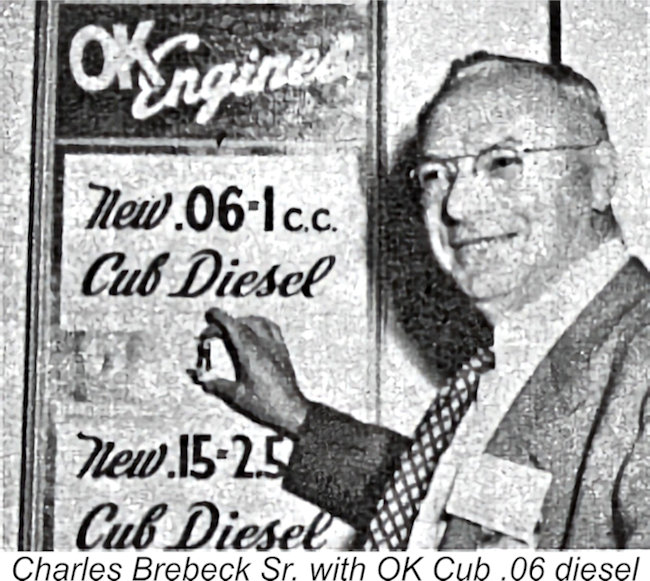
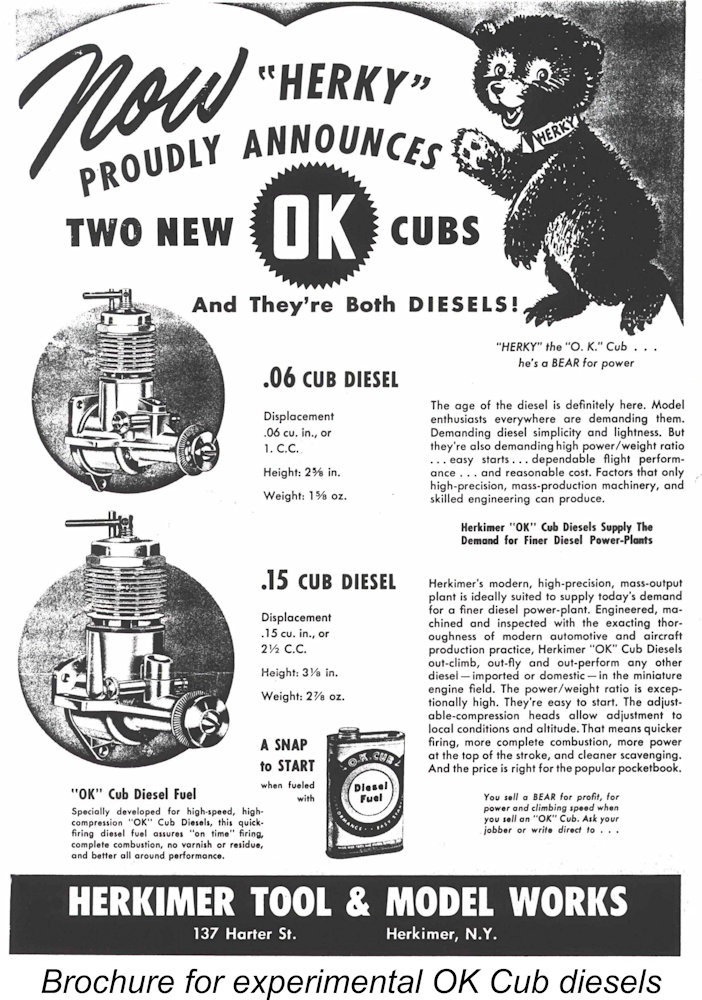
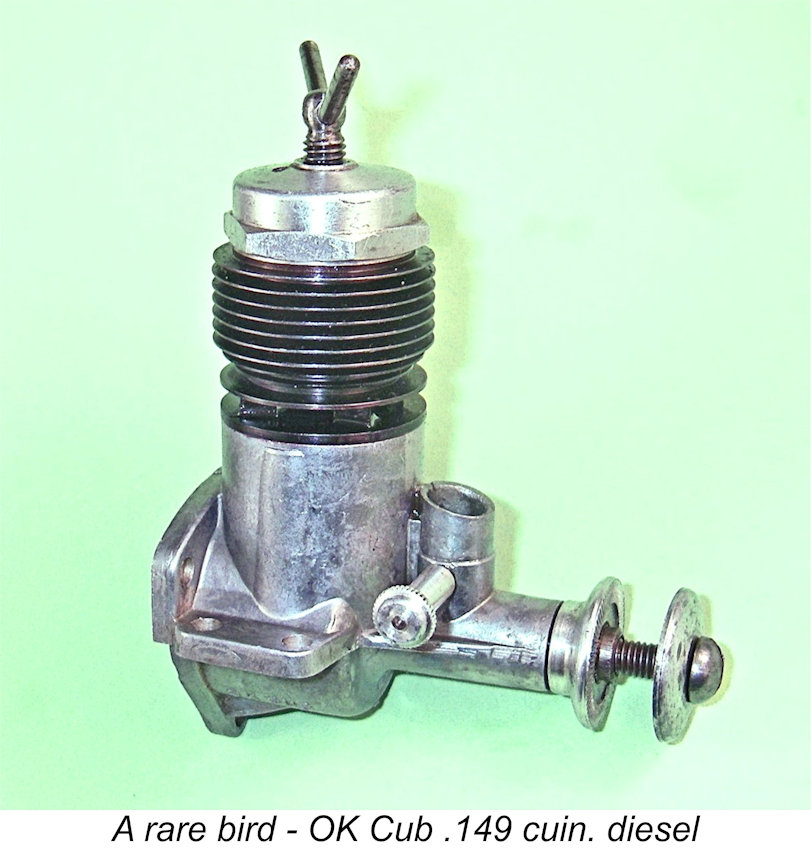
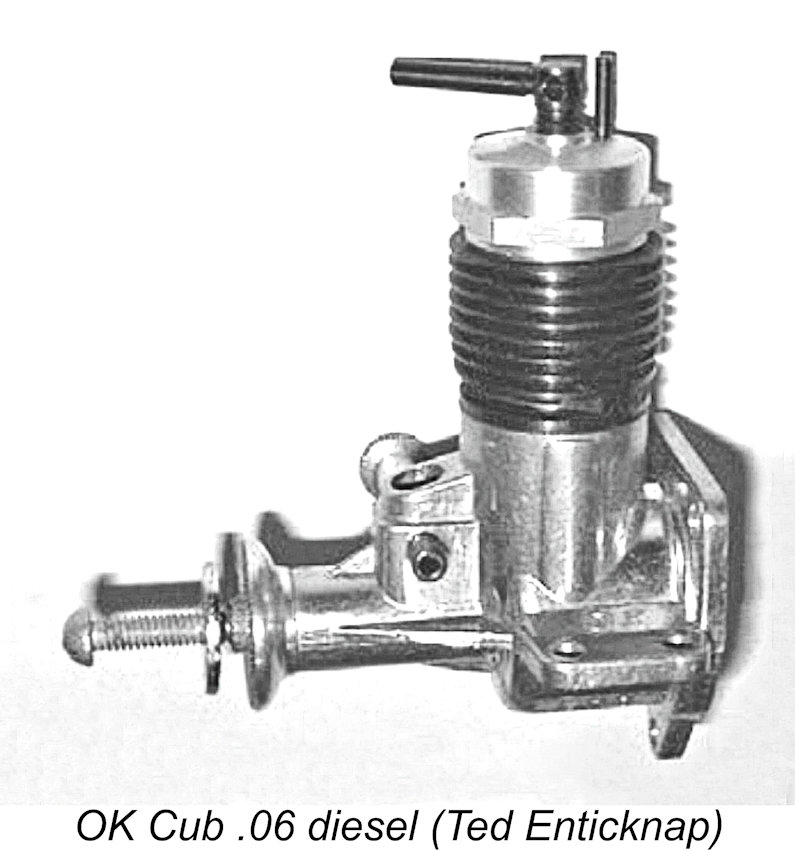 From an overall design standpoint, these two models were essentially identical to the more familiar diesel models which were subsequently to appear. The main visual difference was the fact that the promotional images showed them featuring a single-arm compression lever with a stop pin in the cylinder head, rather along the lines of the
From an overall design standpoint, these two models were essentially identical to the more familiar diesel models which were subsequently to appear. The main visual difference was the fact that the promotional images showed them featuring a single-arm compression lever with a stop pin in the cylinder head, rather along the lines of the 
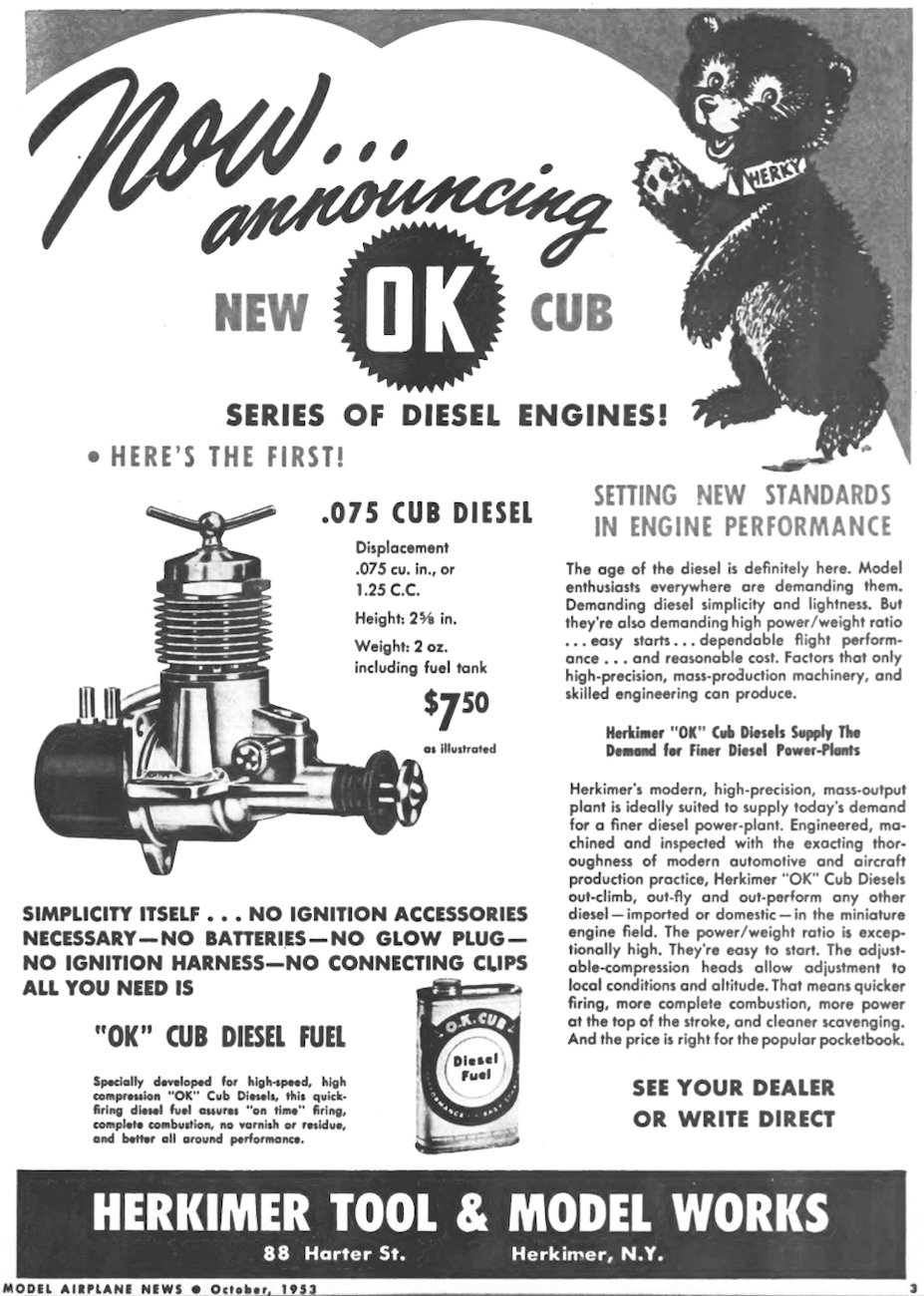 It would appear that the results of the tentative foray into the .15 cuin. category were less than encouraging, since no more was to be heard of any OK diesel model built to that
It would appear that the results of the tentative foray into the .15 cuin. category were less than encouraging, since no more was to be heard of any OK diesel model built to that 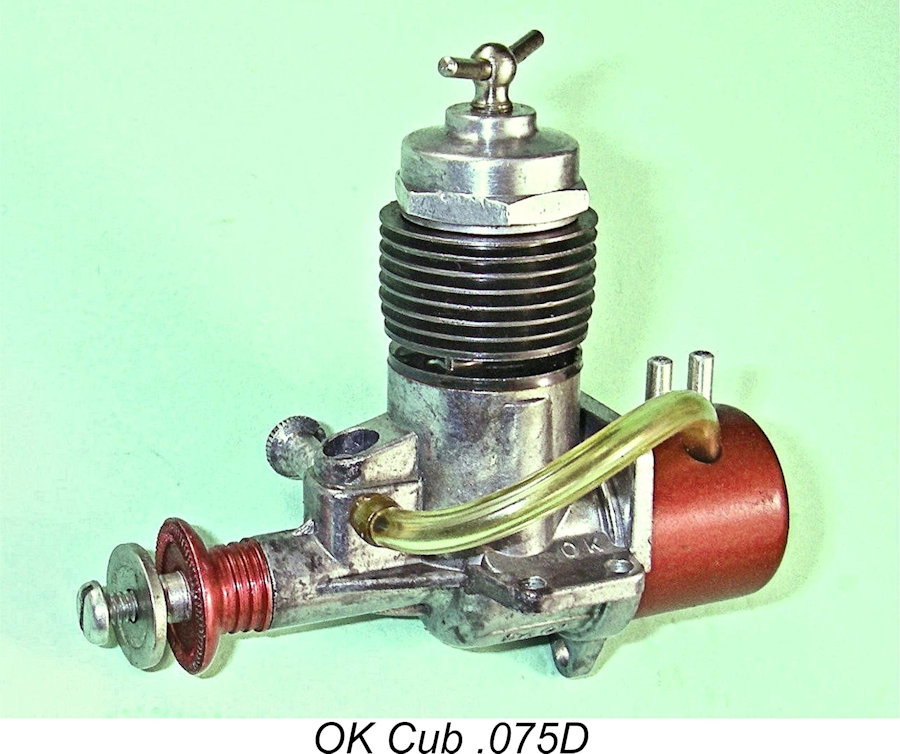
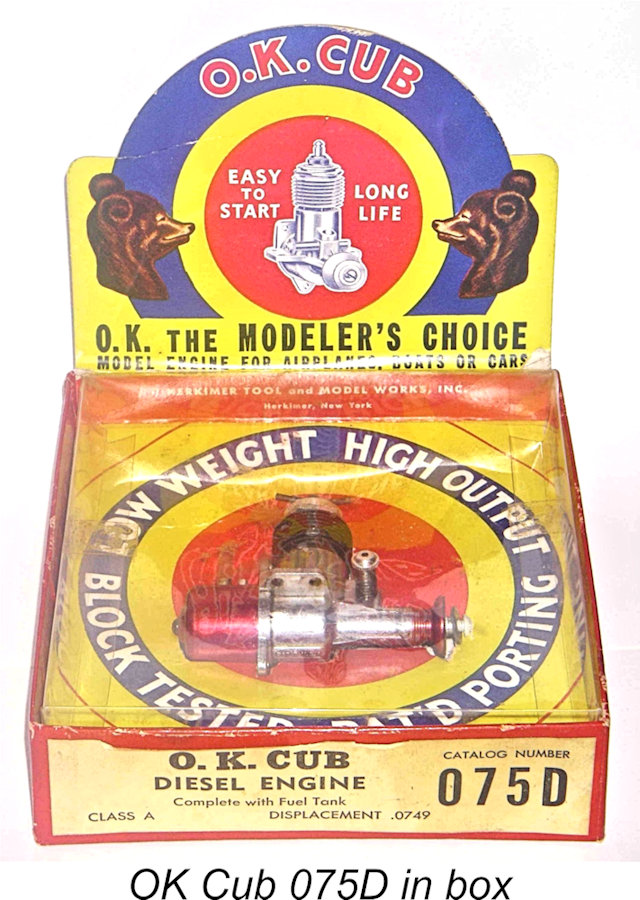 Like its glow-plug relatives, the Cub .075 was strikingly packaged in an eye-catching box with a clear plastic cover so that the engine was clearly visible whilst at the same time remaining fully protected against dust and damage while on display. A fold-up section of the mounting card could be opened up when the engine was on display in a store. A very well-written and comprehensive set of operating instructions were included with each engine together with a spare parts list and an OK brochure describing their full range. There was nothing wrong with OK's marketing strategies!
Like its glow-plug relatives, the Cub .075 was strikingly packaged in an eye-catching box with a clear plastic cover so that the engine was clearly visible whilst at the same time remaining fully protected against dust and damage while on display. A fold-up section of the mounting card could be opened up when the engine was on display in a store. A very well-written and comprehensive set of operating instructions were included with each engine together with a spare parts list and an OK brochure describing their full range. There was nothing wrong with OK's marketing strategies!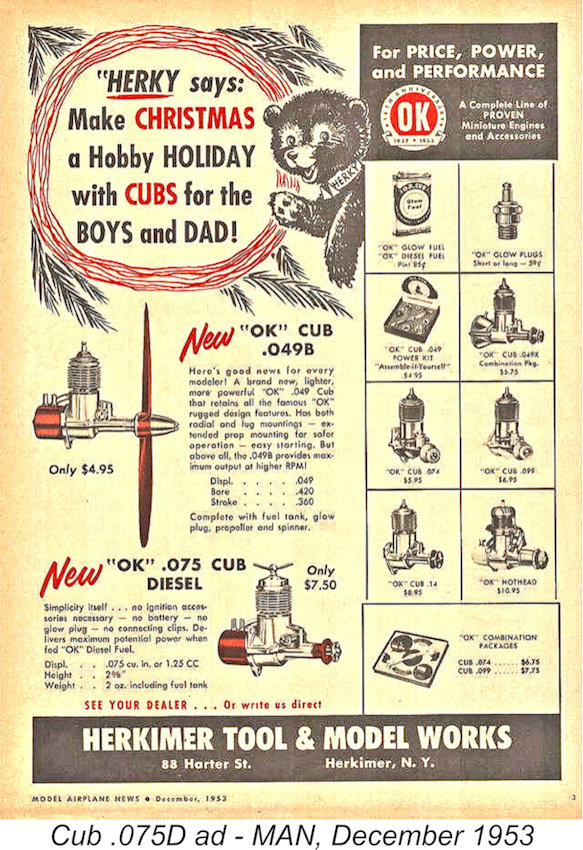 The new .075 diesel model was released to the public in late 1953 and began appearing in articles in the modelling media in early 1954. Its reception was very favorable indeed. Herkimer also developed and marketed their own branded ready-mixed diesel fuel for use in these engines.
The new .075 diesel model was released to the public in late 1953 and began appearing in articles in the modelling media in early 1954. Its reception was very favorable indeed. Herkimer also developed and marketed their own branded ready-mixed diesel fuel for use in these engines.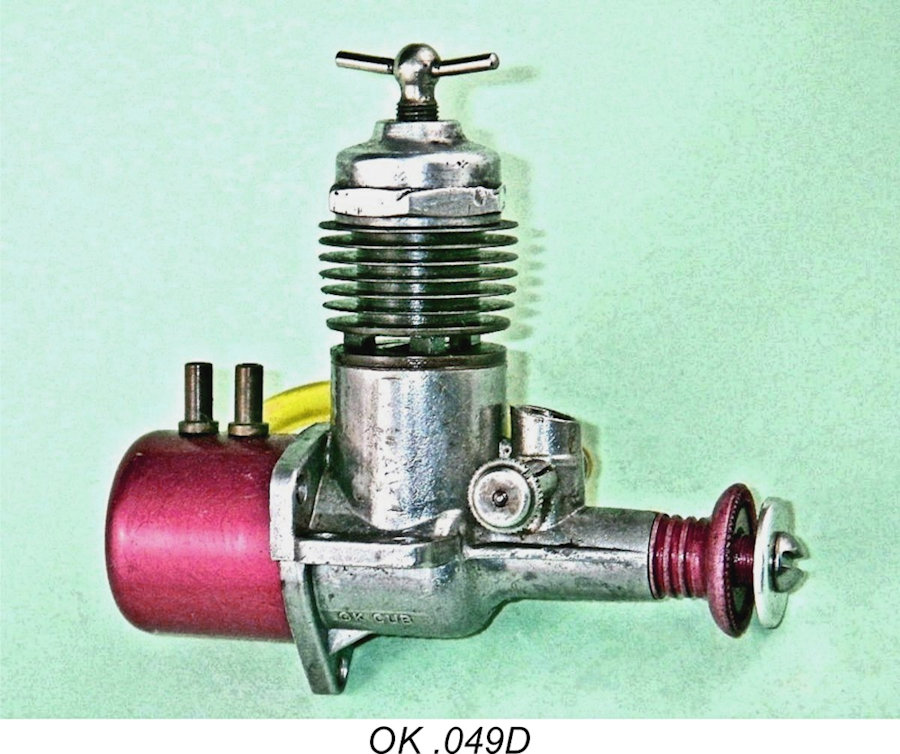 Moving ahead once more to 1954, the positive initial reaction to the .075 diesel prompted an immediate decision to develop a diesel version of the Cub .049B. This appeared on the market in mid-1954, once again to a very favorable reception. In this instance, there was no artificial juggling with the advertised displacement between diesel and glow models. The .049 diesel shared the 0.420 in. (10.67 mm) bore and 0.360 in. (9.14 mm) stroke of its glow-plug sibling. Both diesel and glow-plug models were promoted as having
Moving ahead once more to 1954, the positive initial reaction to the .075 diesel prompted an immediate decision to develop a diesel version of the Cub .049B. This appeared on the market in mid-1954, once again to a very favorable reception. In this instance, there was no artificial juggling with the advertised displacement between diesel and glow models. The .049 diesel shared the 0.420 in. (10.67 mm) bore and 0.360 in. (9.14 mm) stroke of its glow-plug sibling. Both diesel and glow-plug models were promoted as having 
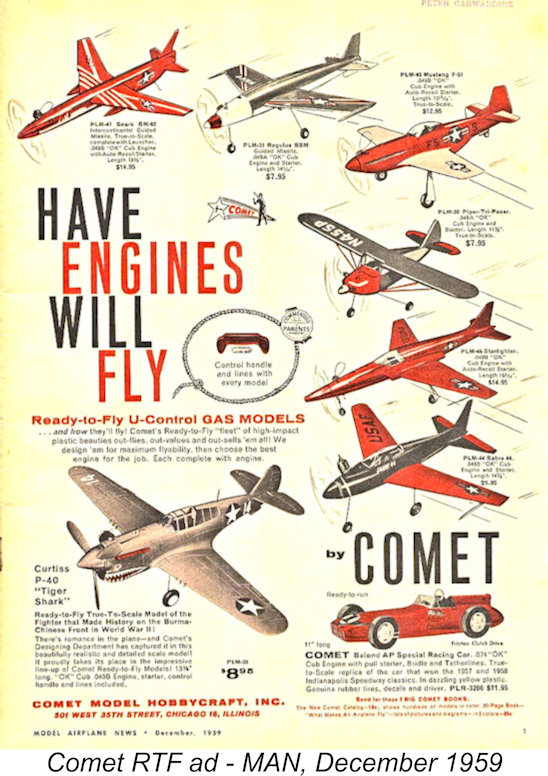 The association with Comet began in the 1950’s, with Herkimer agreeing to supply OK Cub engines to be fitted into Comet’s plastic RTF models. Production of engines for the Comet RTF models came to occupy an increasing and eventually disproportionate percentage of Herkimer's production capacity.
The association with Comet began in the 1950’s, with Herkimer agreeing to supply OK Cub engines to be fitted into Comet’s plastic RTF models. Production of engines for the Comet RTF models came to occupy an increasing and eventually disproportionate percentage of Herkimer's production capacity.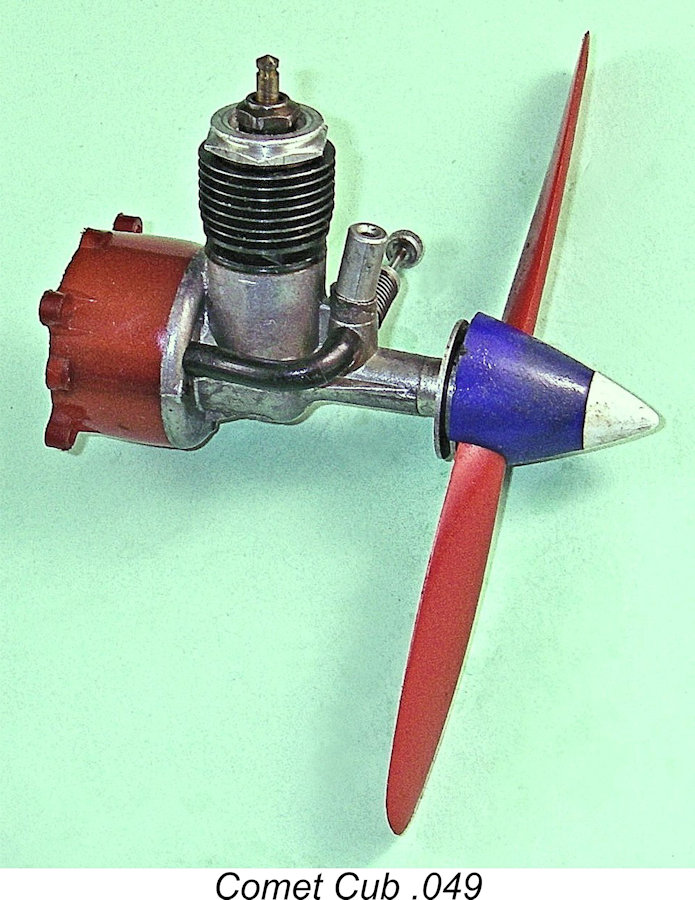
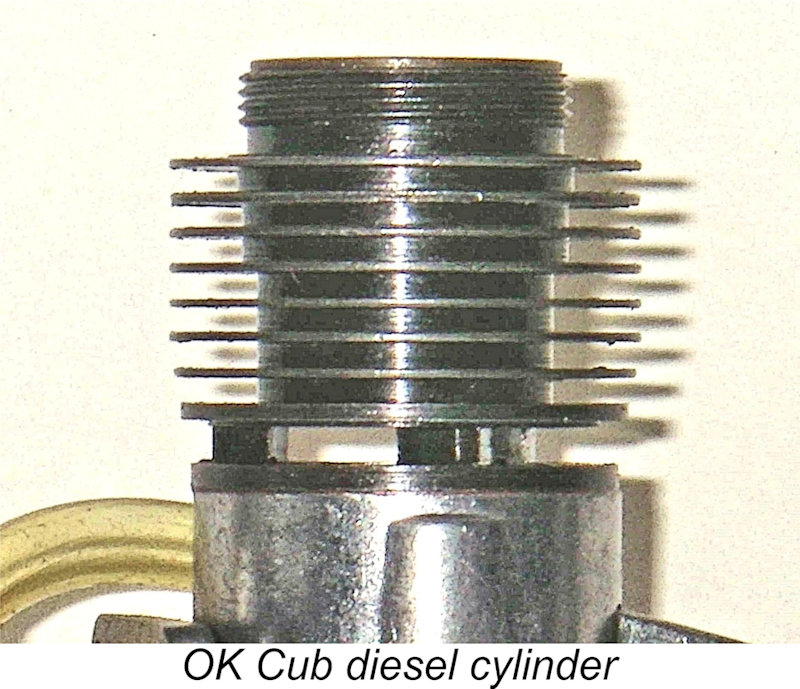 The idea of fixed compression clearly played no part in the design of a "modern" diesel by the time in question. In addition, considerations of production economy dictated that the main casting, bore, stroke and piston dimensions had to remain the same as for the glow-plug models. Therefore, the most obvious requirement was the lengthening of the upper bore to accommodate the necessary contra-piston. This was accomplished by making a new unhardened blued-steel cylinder of generally identical design to that of the glow-plug model apart from having an externally-threaded spigot protruding above the top cooling fin.
The idea of fixed compression clearly played no part in the design of a "modern" diesel by the time in question. In addition, considerations of production economy dictated that the main casting, bore, stroke and piston dimensions had to remain the same as for the glow-plug models. Therefore, the most obvious requirement was the lengthening of the upper bore to accommodate the necessary contra-piston. This was accomplished by making a new unhardened blued-steel cylinder of generally identical design to that of the glow-plug model apart from having an externally-threaded spigot protruding above the top cooling fin.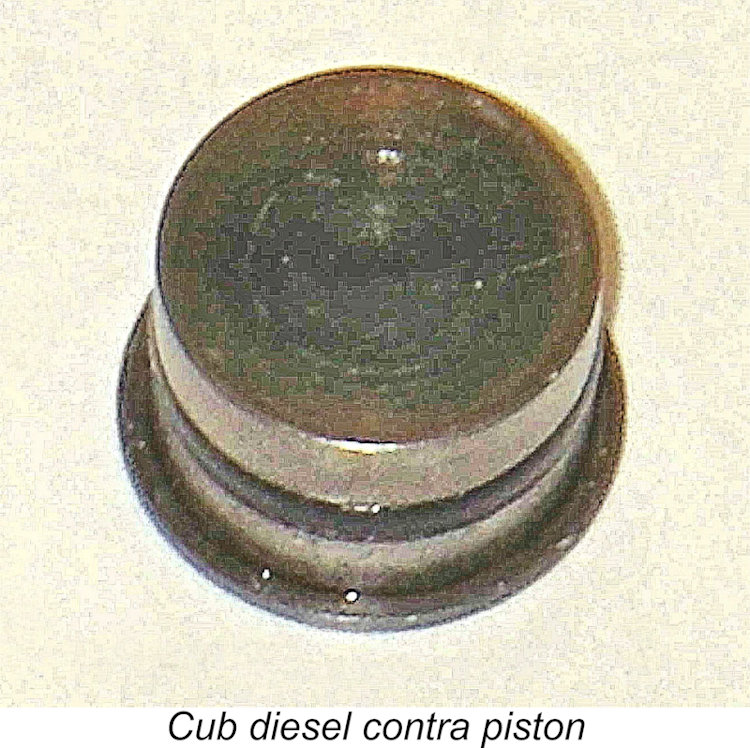 An internally threaded light alloy cylinder head turned from hexagonal bar stock screwed onto this spigot rather like a cap. The steel contra-piston was a smooth sliding push-fit in the upper cylinder, with a good seal being ensured by the use of a heat-resistant plastic O-ring, very much along the lines of the rival McCoy Duro-Glo .049 diesel mentioned earlier. International Model Aircraft were later to emulate this approach in Britain with the Mk. I version of their
An internally threaded light alloy cylinder head turned from hexagonal bar stock screwed onto this spigot rather like a cap. The steel contra-piston was a smooth sliding push-fit in the upper cylinder, with a good seal being ensured by the use of a heat-resistant plastic O-ring, very much along the lines of the rival McCoy Duro-Glo .049 diesel mentioned earlier. International Model Aircraft were later to emulate this approach in Britain with the Mk. I version of their 
 It should be clear from the above that the crankshafts and conrods of the respective diesel and glow-plug models are not directly interchangeable. All other components apart from the cylinder and head were essentially identical to those used in the standard glow-plug models, albeit with a somewhat tighter piston/cylinder fit being generally applied.
It should be clear from the above that the crankshafts and conrods of the respective diesel and glow-plug models are not directly interchangeable. All other components apart from the cylinder and head were essentially identical to those used in the standard glow-plug models, albeit with a somewhat tighter piston/cylinder fit being generally applied.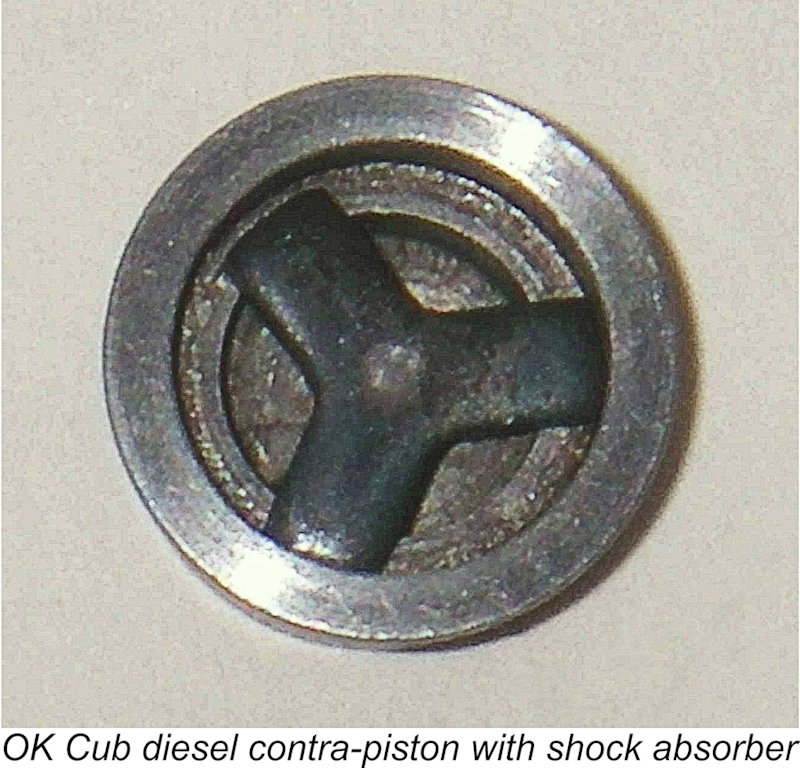 The answer was immediately obvious to Brebeck - if you can't arrange for the entire cylinder and head to have some "give", you can at least arrange for the contra-piston to perform a similar function in a diesel! This is exactly what he did - the contra-piston had a narrow shelf machined into its interior, and a three-legged spacer stamped from hardened and tempered 1/16 in. spring steel was inserted into the top of the contra piston with the outer ends of its three "legs" resting on the shelf. The compression screw naturally bore against the centre of this steel spacer, with the forces of compression and combustion being transmitted to the comp screw through the three "legs" resting on the shelf in the contra piston.
The answer was immediately obvious to Brebeck - if you can't arrange for the entire cylinder and head to have some "give", you can at least arrange for the contra-piston to perform a similar function in a diesel! This is exactly what he did - the contra-piston had a narrow shelf machined into its interior, and a three-legged spacer stamped from hardened and tempered 1/16 in. spring steel was inserted into the top of the contra piston with the outer ends of its three "legs" resting on the shelf. The compression screw naturally bore against the centre of this steel spacer, with the forces of compression and combustion being transmitted to the comp screw through the three "legs" resting on the shelf in the contra piston.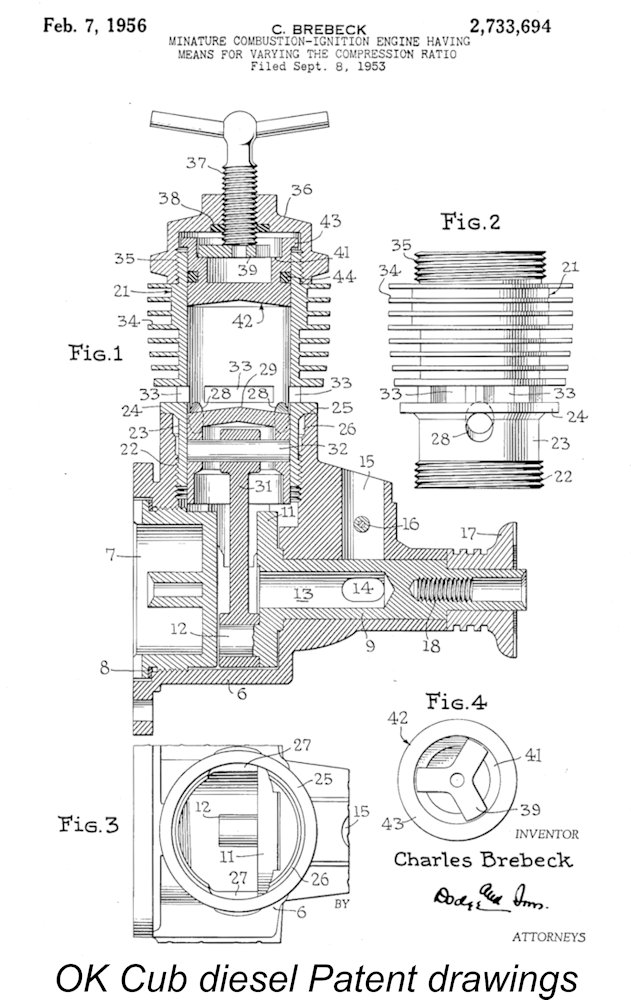
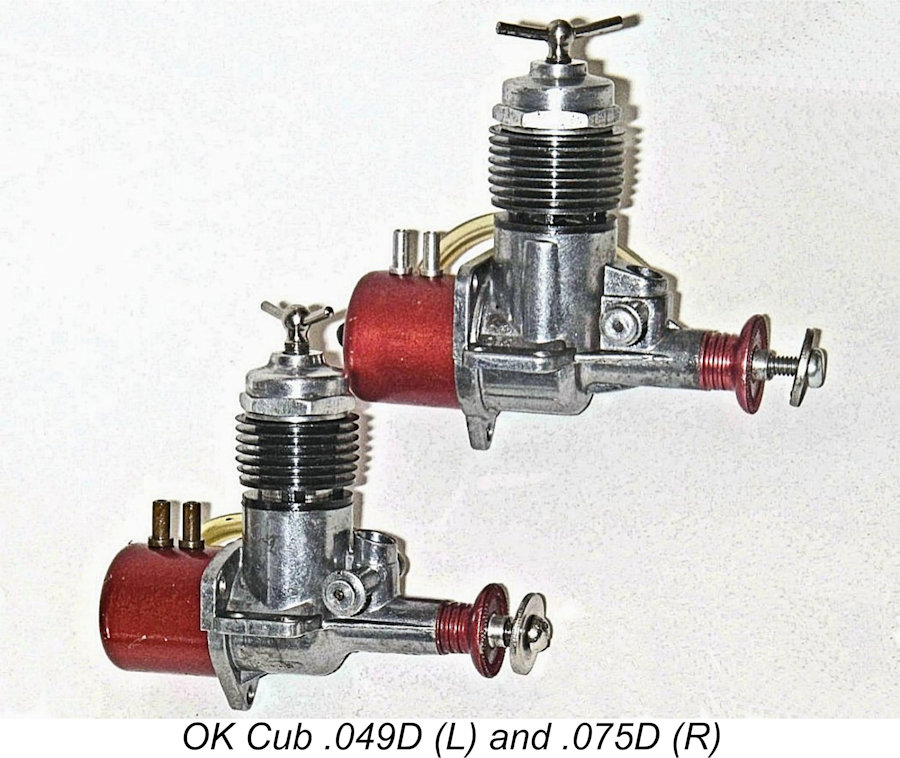 The
The 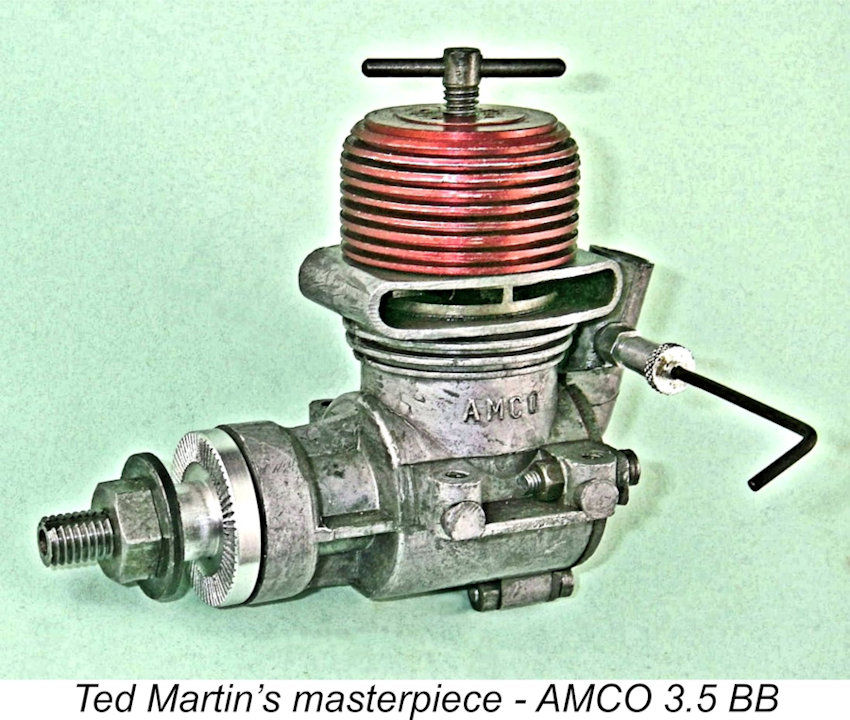 Martin undoubtedly saw a great future for the small-displacement model diesel in North America. Furthermore, he was not a man to confine himself to mere words - his forte was action! In 1951, while still completing the development of the AMCO 3.5 BB, he was also evolving a design concept for an .049 diesel that would sweep all before it in the US marketplace. The sales potential for such an engine was clearly enormous if the American consumer could be won over.
Martin undoubtedly saw a great future for the small-displacement model diesel in North America. Furthermore, he was not a man to confine himself to mere words - his forte was action! In 1951, while still completing the development of the AMCO 3.5 BB, he was also evolving a design concept for an .049 diesel that would sweep all before it in the US marketplace. The sales potential for such an engine was clearly enormous if the American consumer could be won over. the release of the AMCO 3.5 BB by Anchor Motor Co., Martin not only left the company but also left England! On January 5
the release of the AMCO 3.5 BB by Anchor Motor Co., Martin not only left the company but also left England! On January 5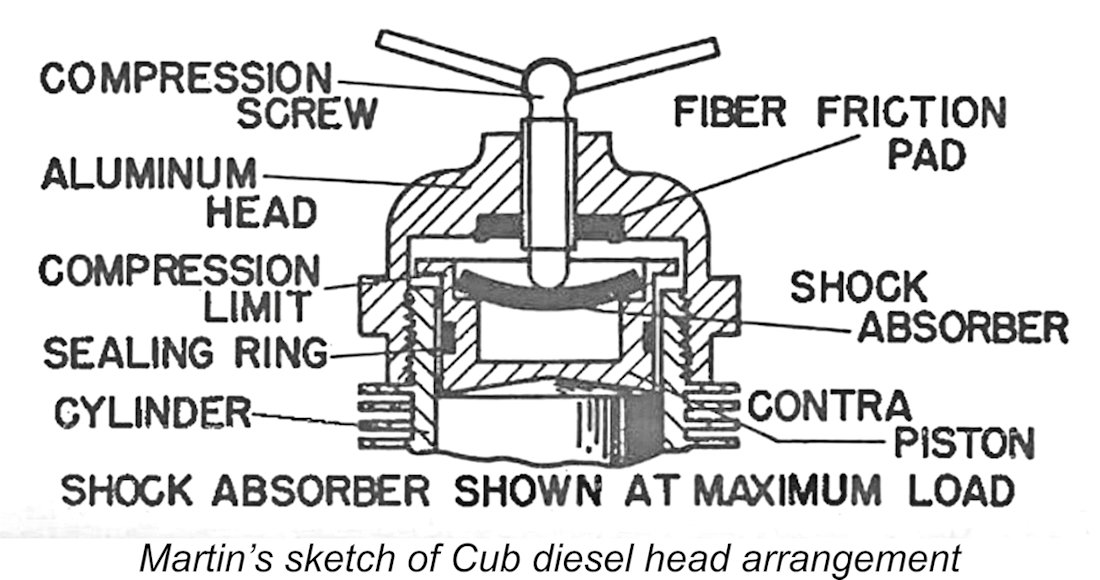 Martin commented on the previously-noted measures which had been taken to beef up the rod and crankshaft, but his major interest was naturally focused upon the unique "shock absorber" system built into the head. He described the manner in which this was supposed to work (discussed earlier) in considerable detail, crediting the new system with permitting the continuing use of most components of the Cub .074 glow model with minimal modification. Rightly or wrongly, he attributed the engine's extraordinarily smooth running characteristics directly to the "shock absorber". His very informative sketch of the system is attached for reference.
Martin commented on the previously-noted measures which had been taken to beef up the rod and crankshaft, but his major interest was naturally focused upon the unique "shock absorber" system built into the head. He described the manner in which this was supposed to work (discussed earlier) in considerable detail, crediting the new system with permitting the continuing use of most components of the Cub .074 glow model with minimal modification. Rightly or wrongly, he attributed the engine's extraordinarily smooth running characteristics directly to the "shock absorber". His very informative sketch of the system is attached for reference. 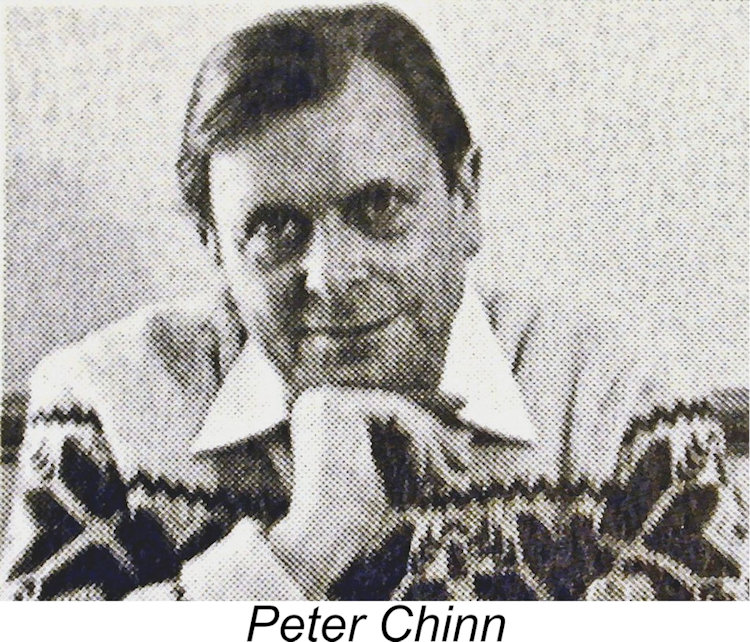 The “
The “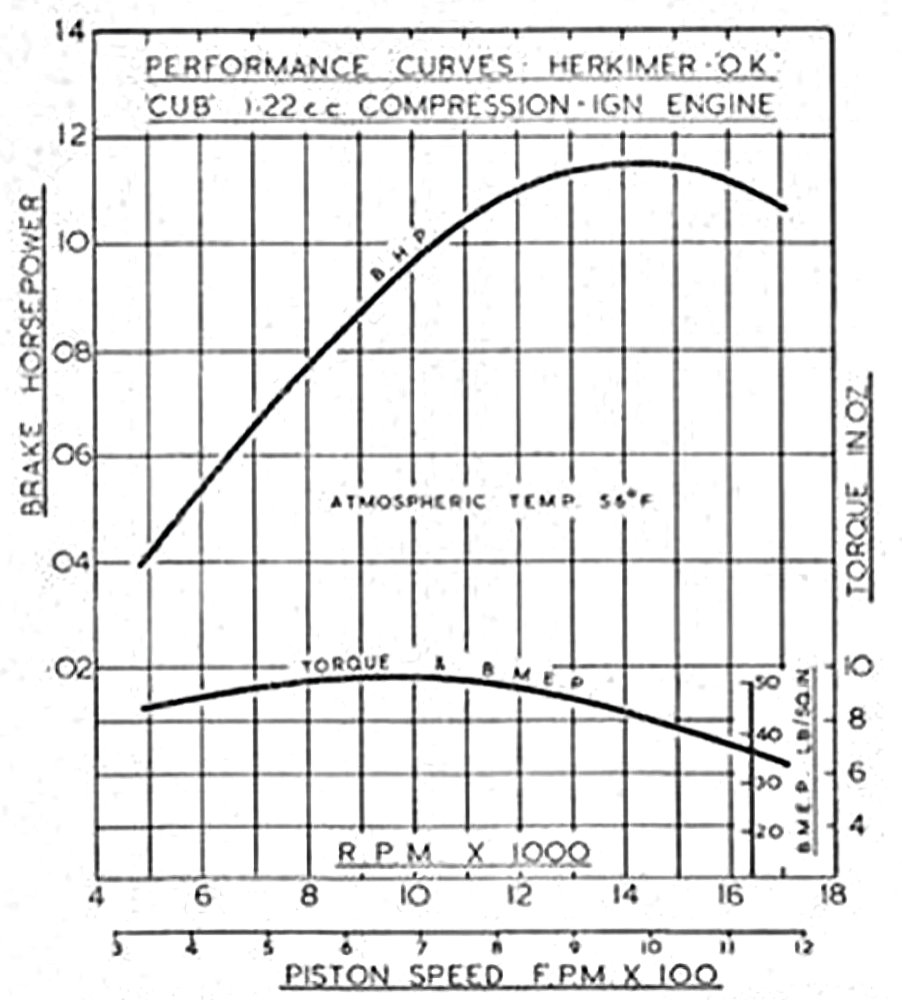 Unlike Martin, Chinn did not publish any propeller-rpm figures, so a direct comparison between the two tests is not possible in performance terms. However, Chinn more than made up for this by running-in the engine for 1 hour and then developing his usual torque and BHP curves, finding a peak power output of 0.115 BHP at 14,000 rpm. This represented a specific output of some 94 BHP/litre, which was very much up to par with the best contemporary performance standards for commercially-produced British sports diesels of this general displacement. In addition, the 2.10 ounce (59 gm) Cub weighed considerably less than any of its British competitors. Chinn's curves are reproduced at the left.
Unlike Martin, Chinn did not publish any propeller-rpm figures, so a direct comparison between the two tests is not possible in performance terms. However, Chinn more than made up for this by running-in the engine for 1 hour and then developing his usual torque and BHP curves, finding a peak power output of 0.115 BHP at 14,000 rpm. This represented a specific output of some 94 BHP/litre, which was very much up to par with the best contemporary performance standards for commercially-produced British sports diesels of this general displacement. In addition, the 2.10 ounce (59 gm) Cub weighed considerably less than any of its British competitors. Chinn's curves are reproduced at the left. 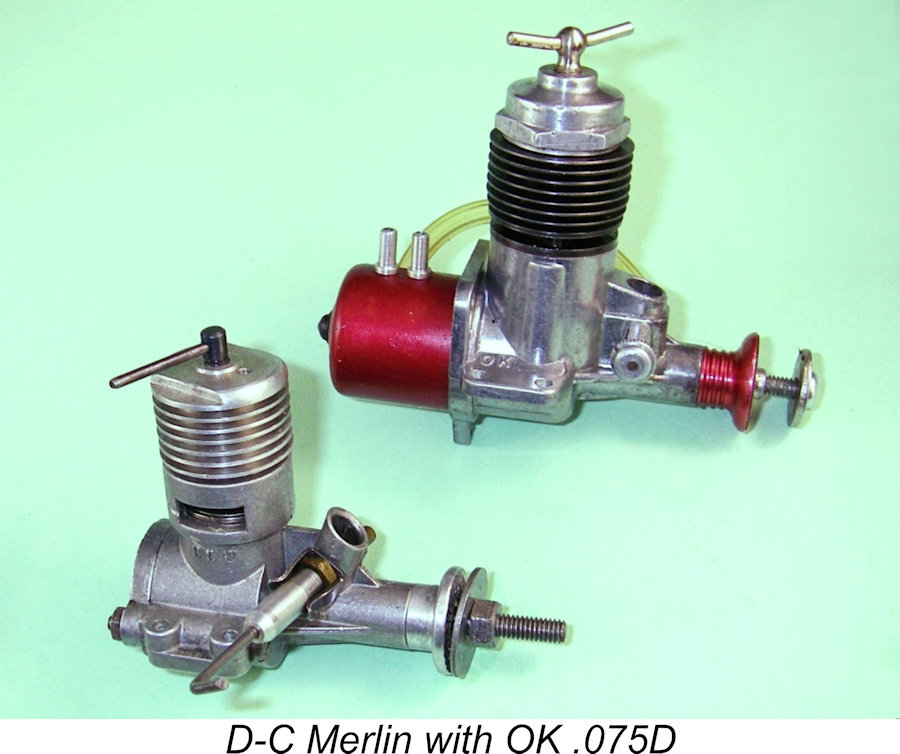 To a person like myself who cut his teeth on British sports diesels like the
To a person like myself who cut his teeth on British sports diesels like the  Starting is just as Ted Martin described it - dead easy and completely free from vices of any kind. I’ve found that the engine likes an exhaust prime with the compression backed off a little, but once that's done starting is pretty much instantaneous if the settings are anywhere near correct. All that you have to do is "catch" the engine by raising the compression as the prime burns off.
Starting is just as Ted Martin described it - dead easy and completely free from vices of any kind. I’ve found that the engine likes an exhaust prime with the compression backed off a little, but once that's done starting is pretty much instantaneous if the settings are anywhere near correct. All that you have to do is "catch" the engine by raising the compression as the prime burns off.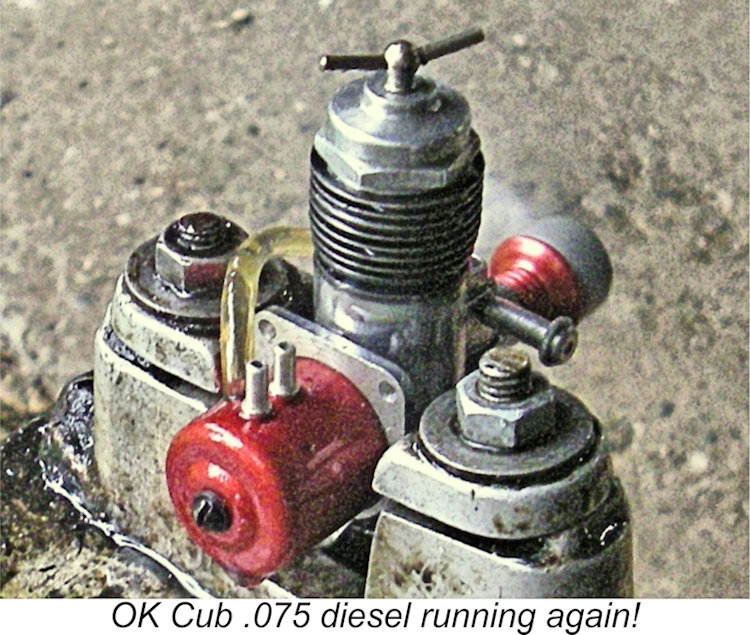 For the same reason, there's no way that these engines will run successfully at or near peak RPM on a fuel with less than, say, 1½% ignition improver (amyl nitrate or equivalent). On straight fuel there's just not enough compression available to smooth out the running at anything approaching optimal operating speeds.
For the same reason, there's no way that these engines will run successfully at or near peak RPM on a fuel with less than, say, 1½% ignition improver (amyl nitrate or equivalent). On straight fuel there's just not enough compression available to smooth out the running at anything approaching optimal operating speeds.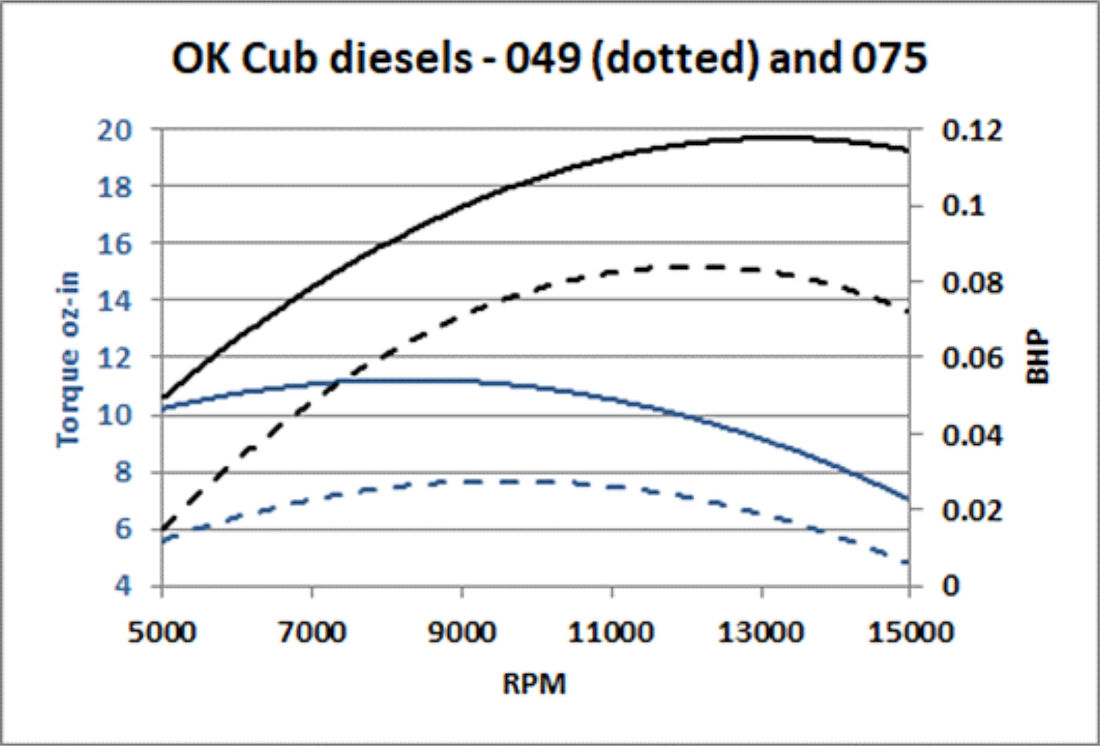
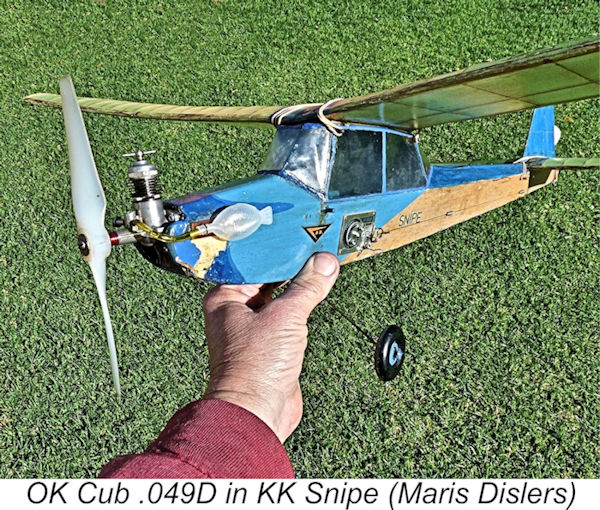
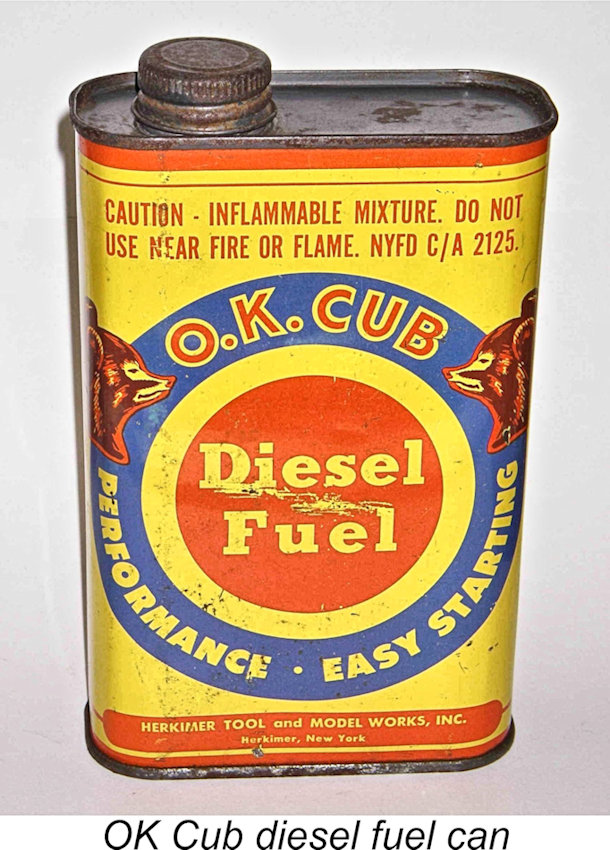 Many thousands of these Cub diesels were made and sold, most of them in North America. A good number of these received little if any use - their owners soon reverted to the safe and comfortably familiar haven of glow-plug operation. In very large part, this appears to have been due to the somewhat sporadic availability of diesel fuel in American hobby shops. The excellent diesel fuels sold by both Herkimer and McCoy seem to have been overlooked all too frequently in the order books of many retail outlets. A number of American old-timers have commented on the various modelling forums that they gave up on diesels during the 1950's for exactly this reason.
Many thousands of these Cub diesels were made and sold, most of them in North America. A good number of these received little if any use - their owners soon reverted to the safe and comfortably familiar haven of glow-plug operation. In very large part, this appears to have been due to the somewhat sporadic availability of diesel fuel in American hobby shops. The excellent diesel fuels sold by both Herkimer and McCoy seem to have been overlooked all too frequently in the order books of many retail outlets. A number of American old-timers have commented on the various modelling forums that they gave up on diesels during the 1950's for exactly this reason. 